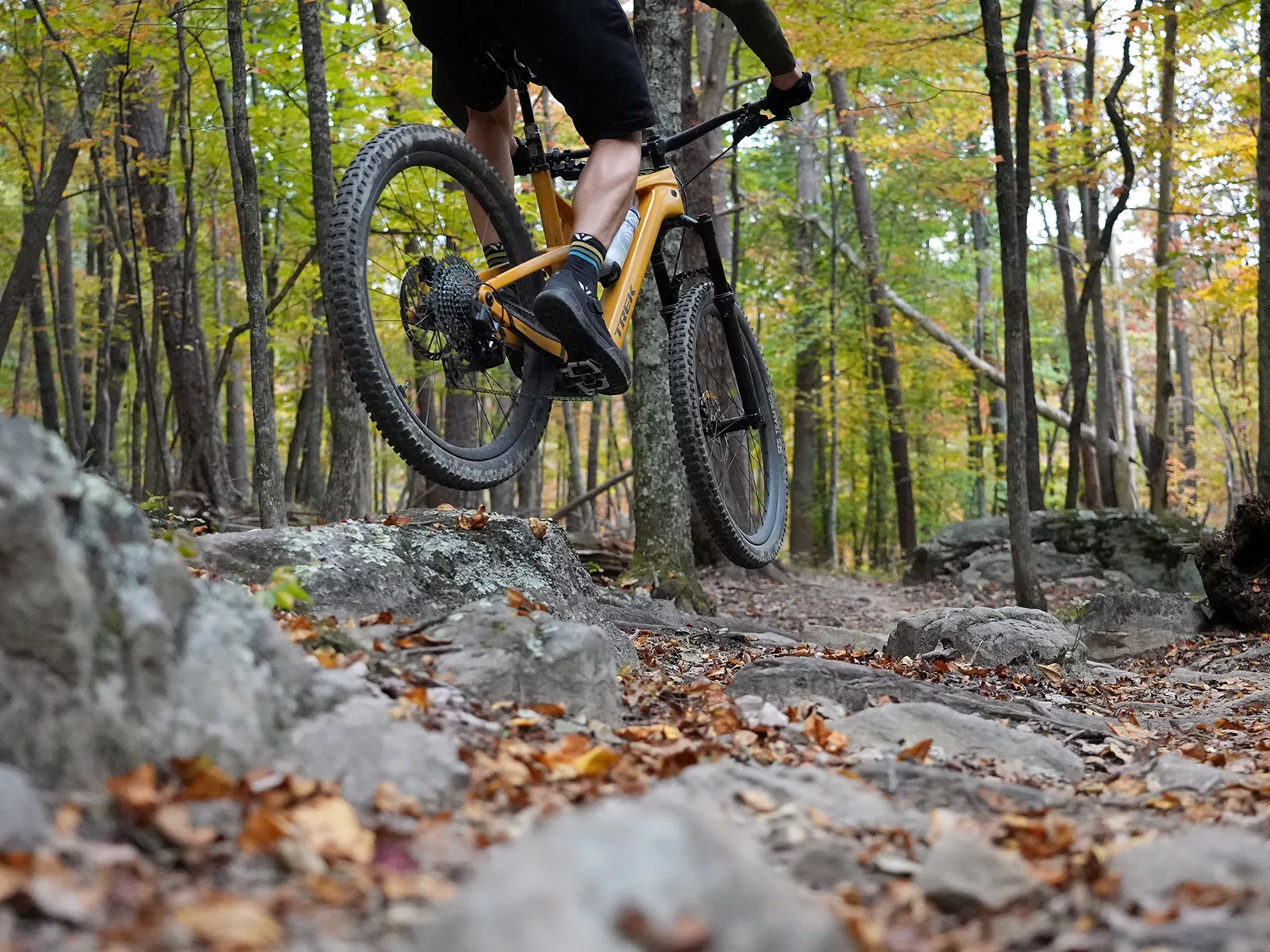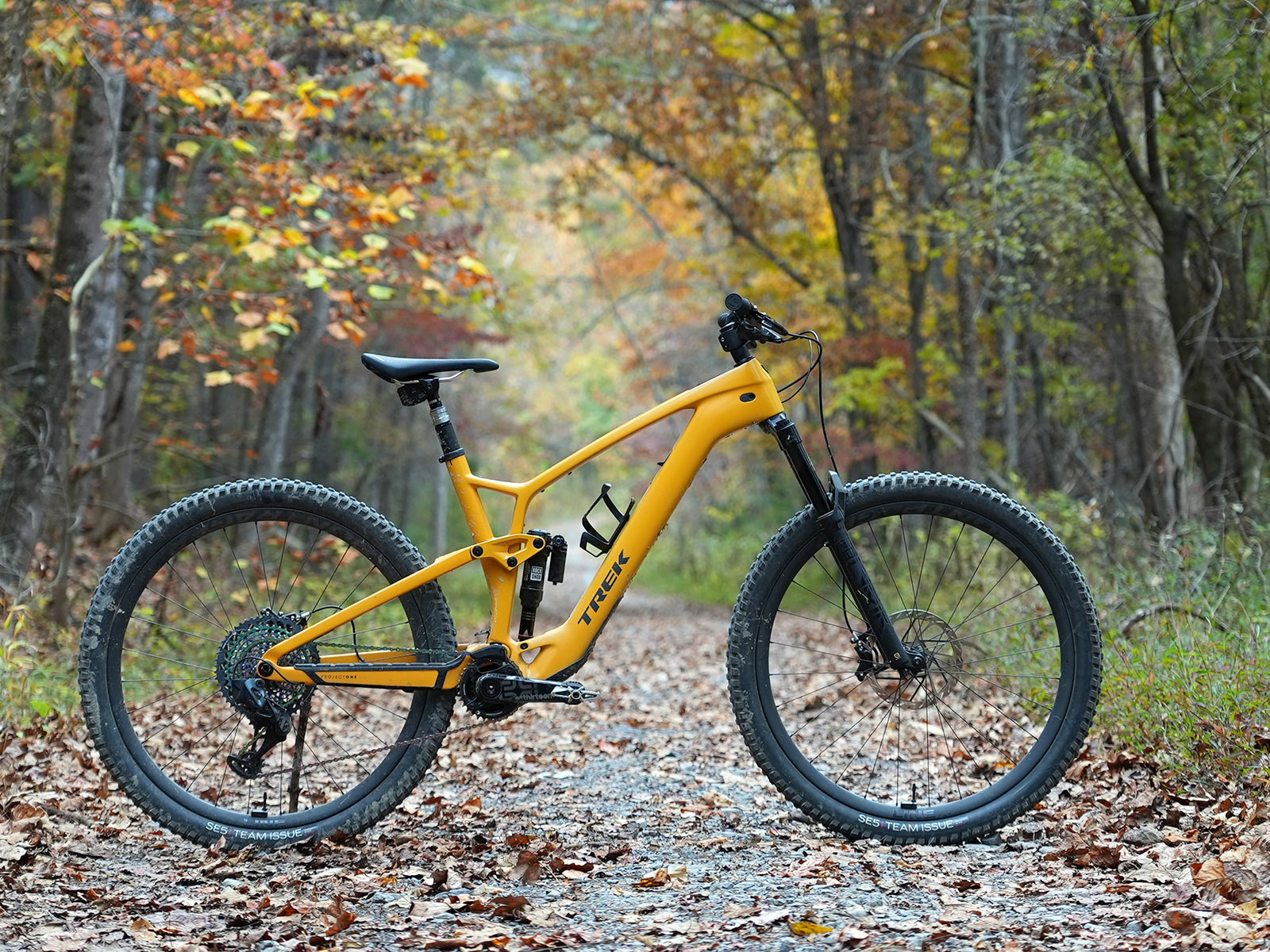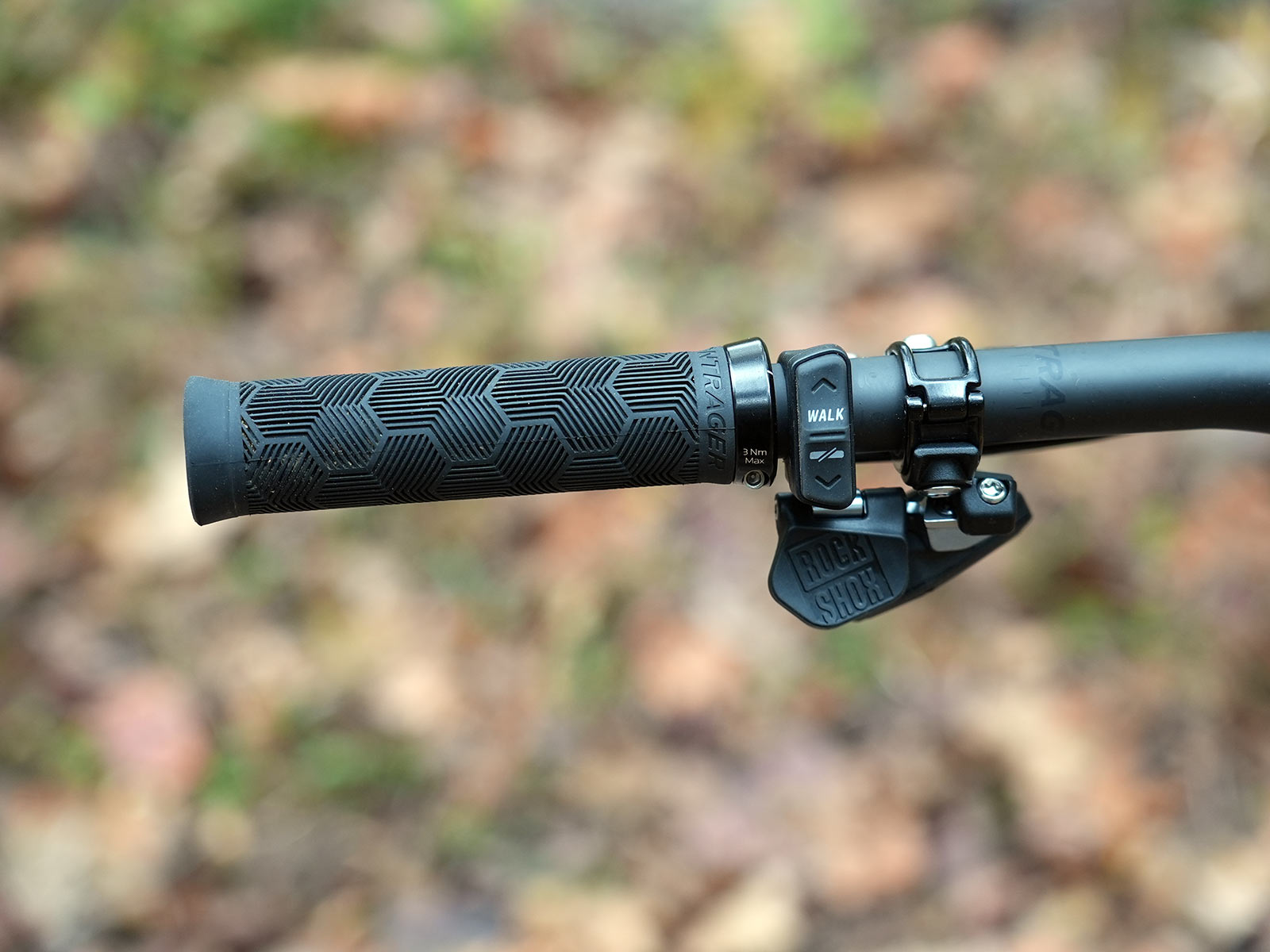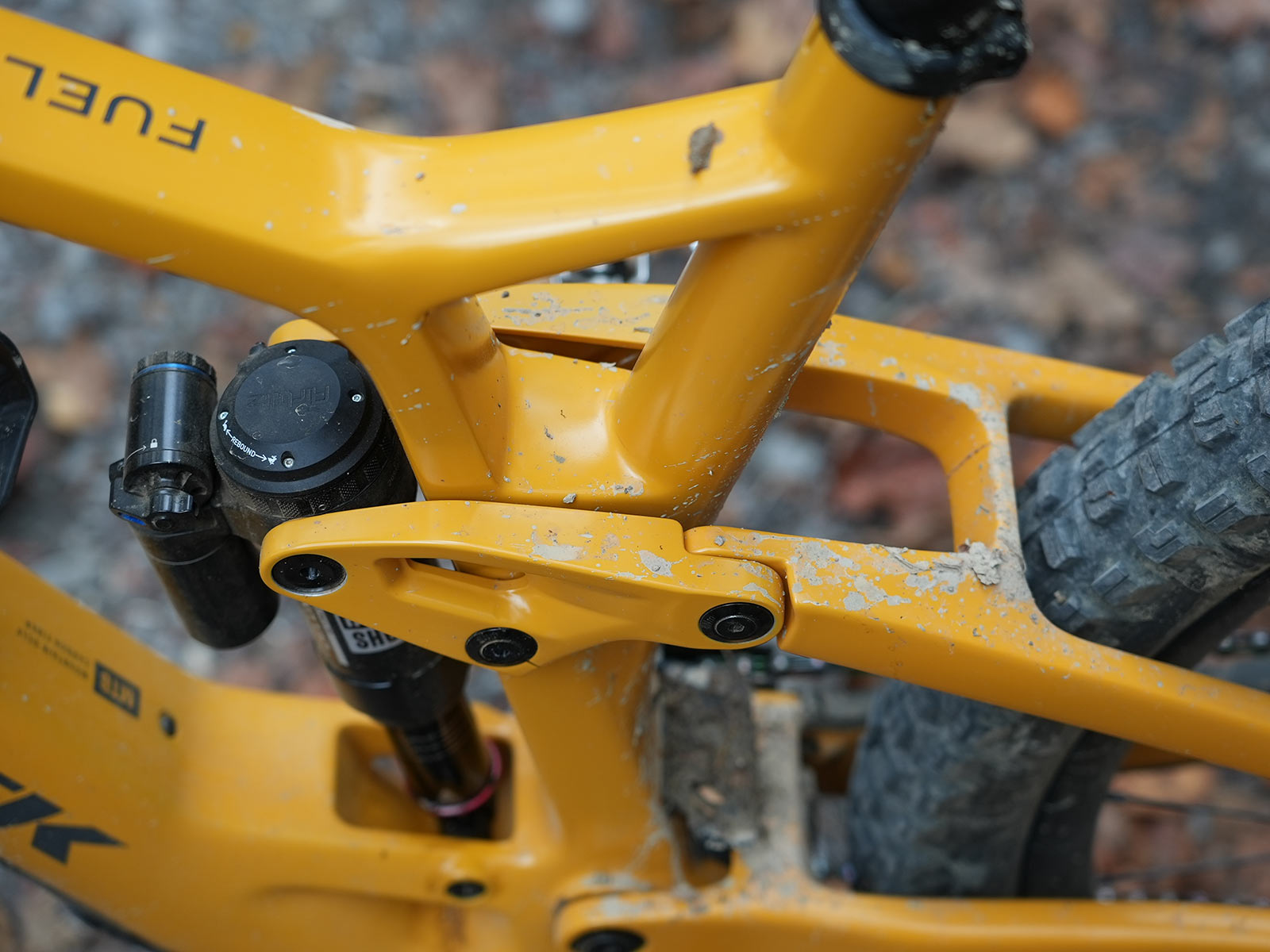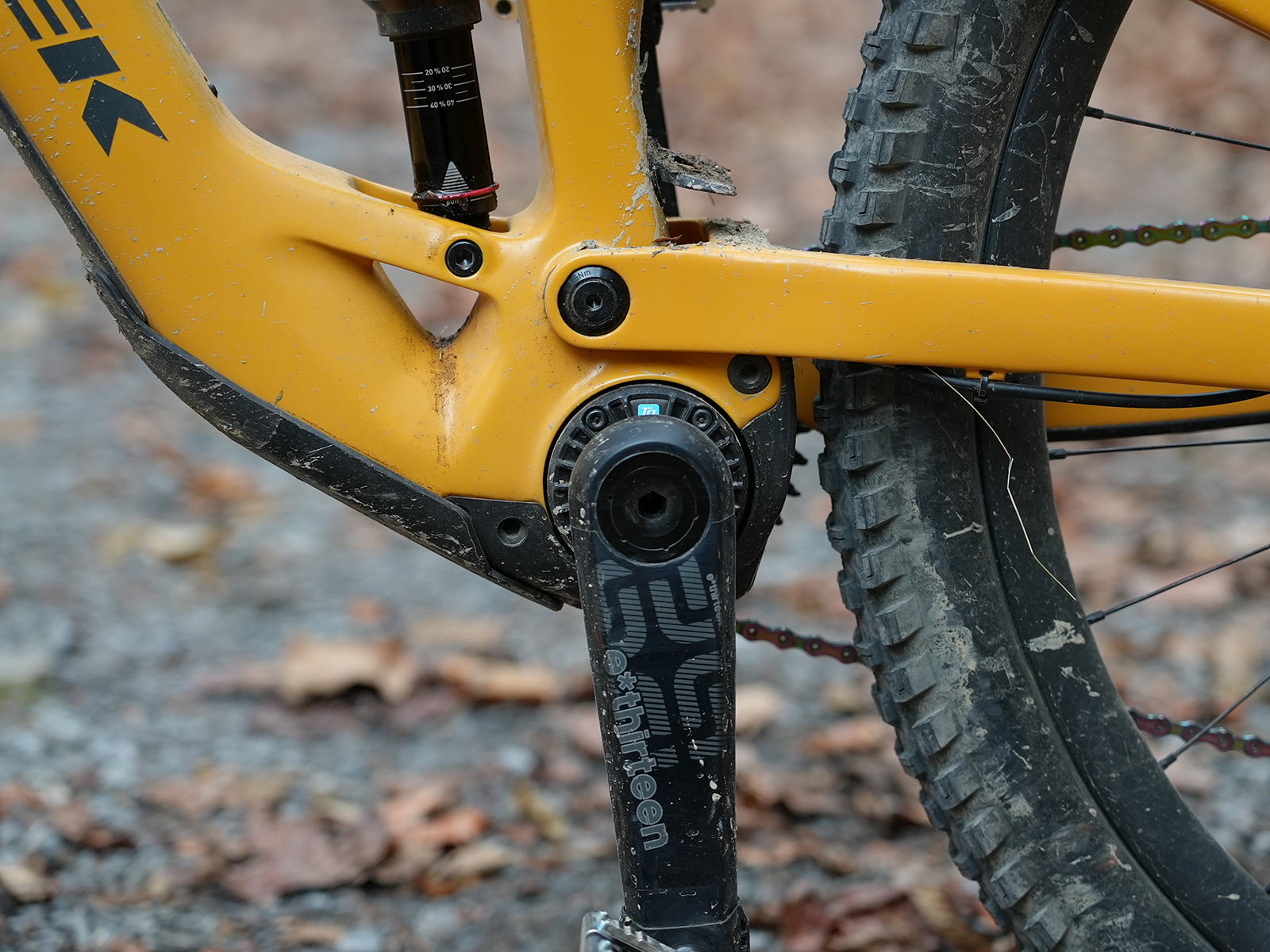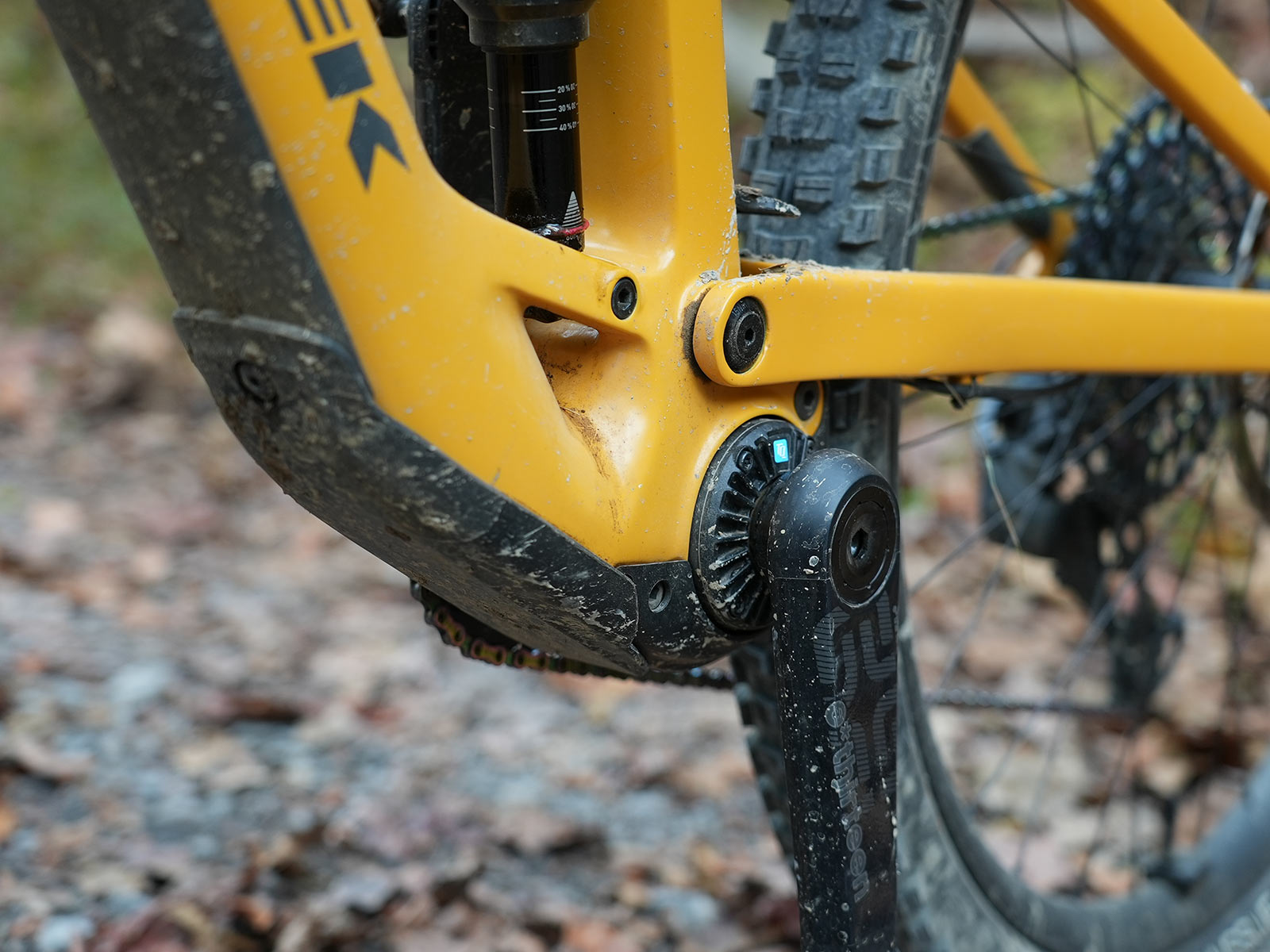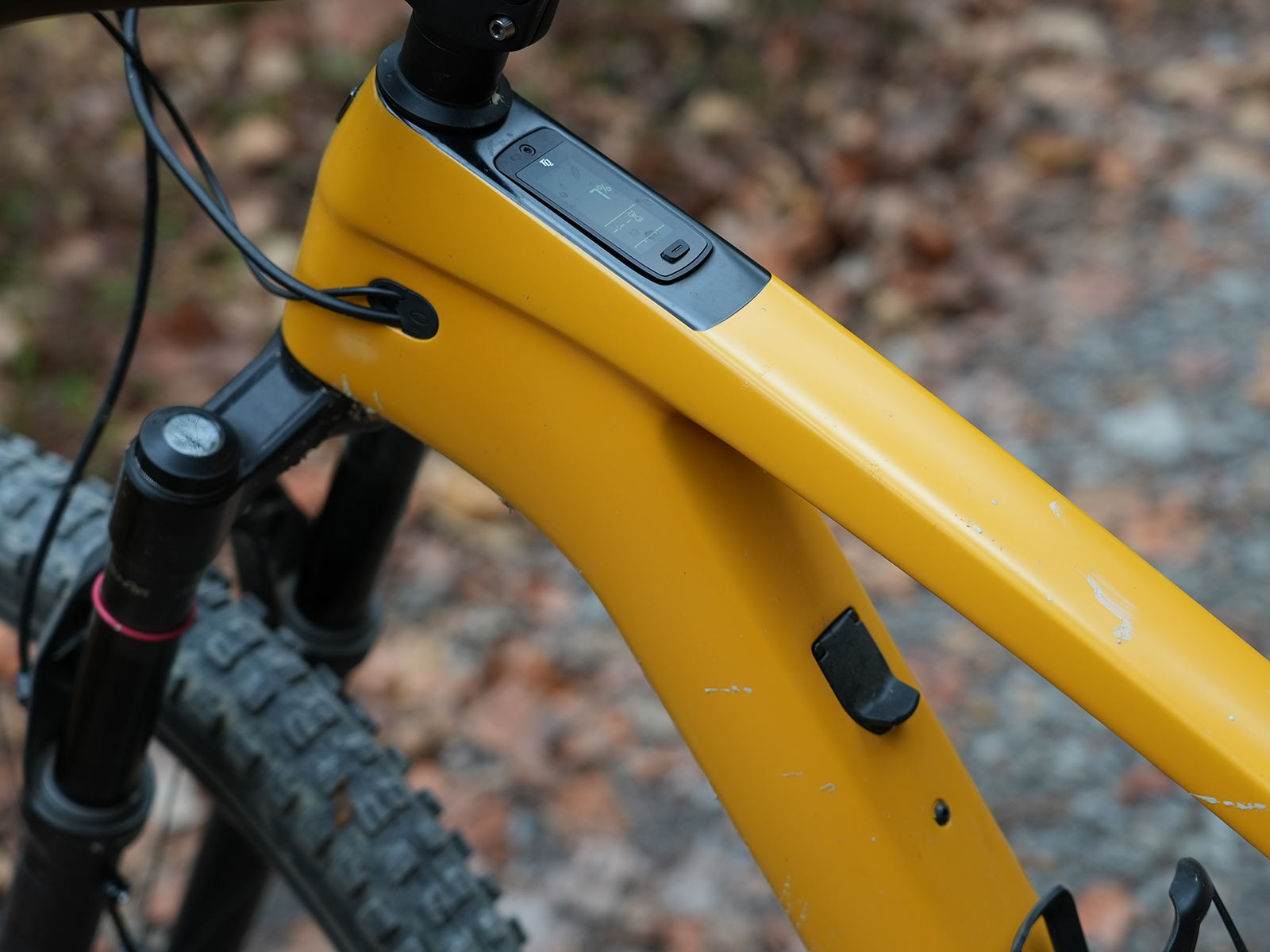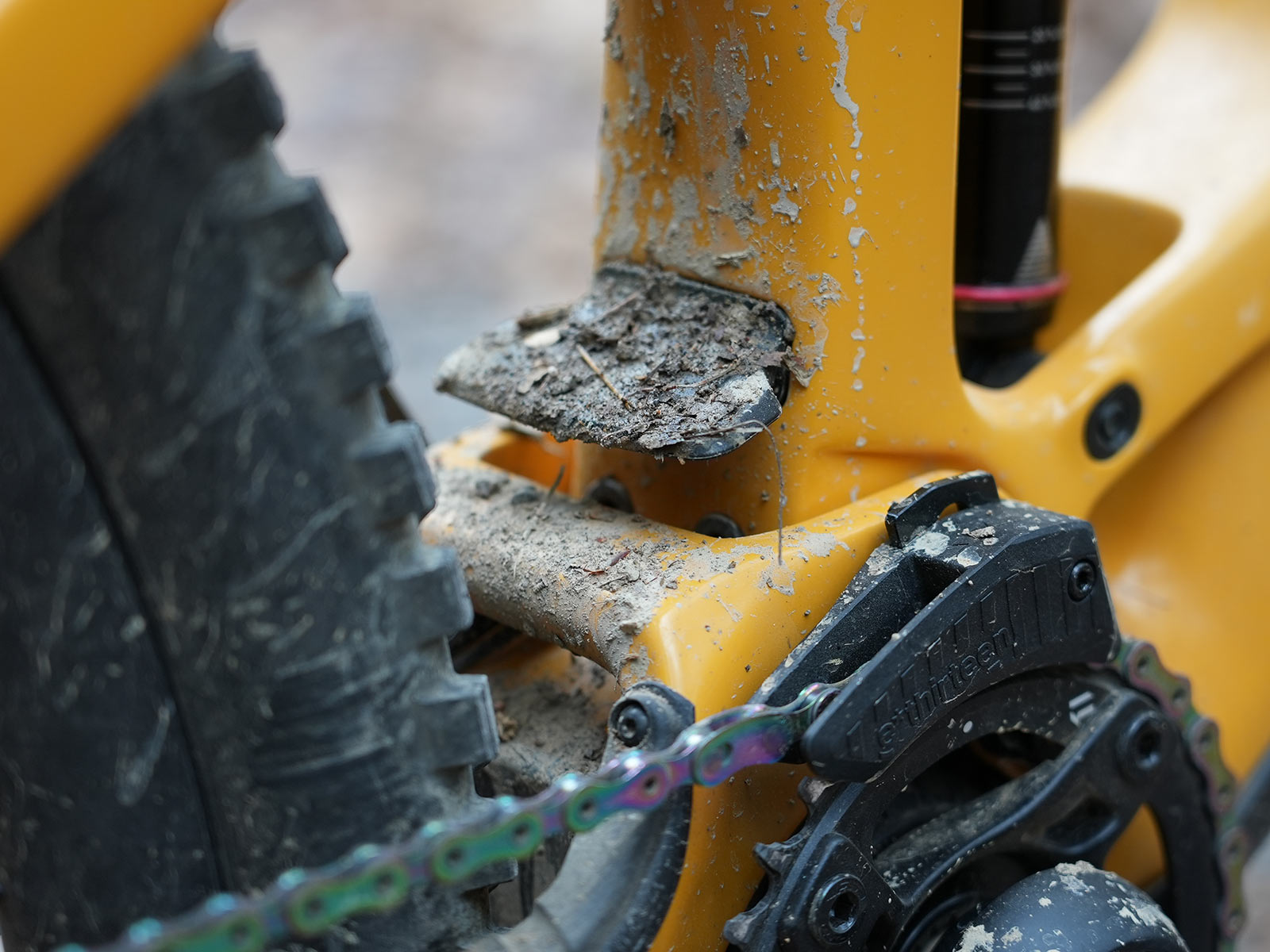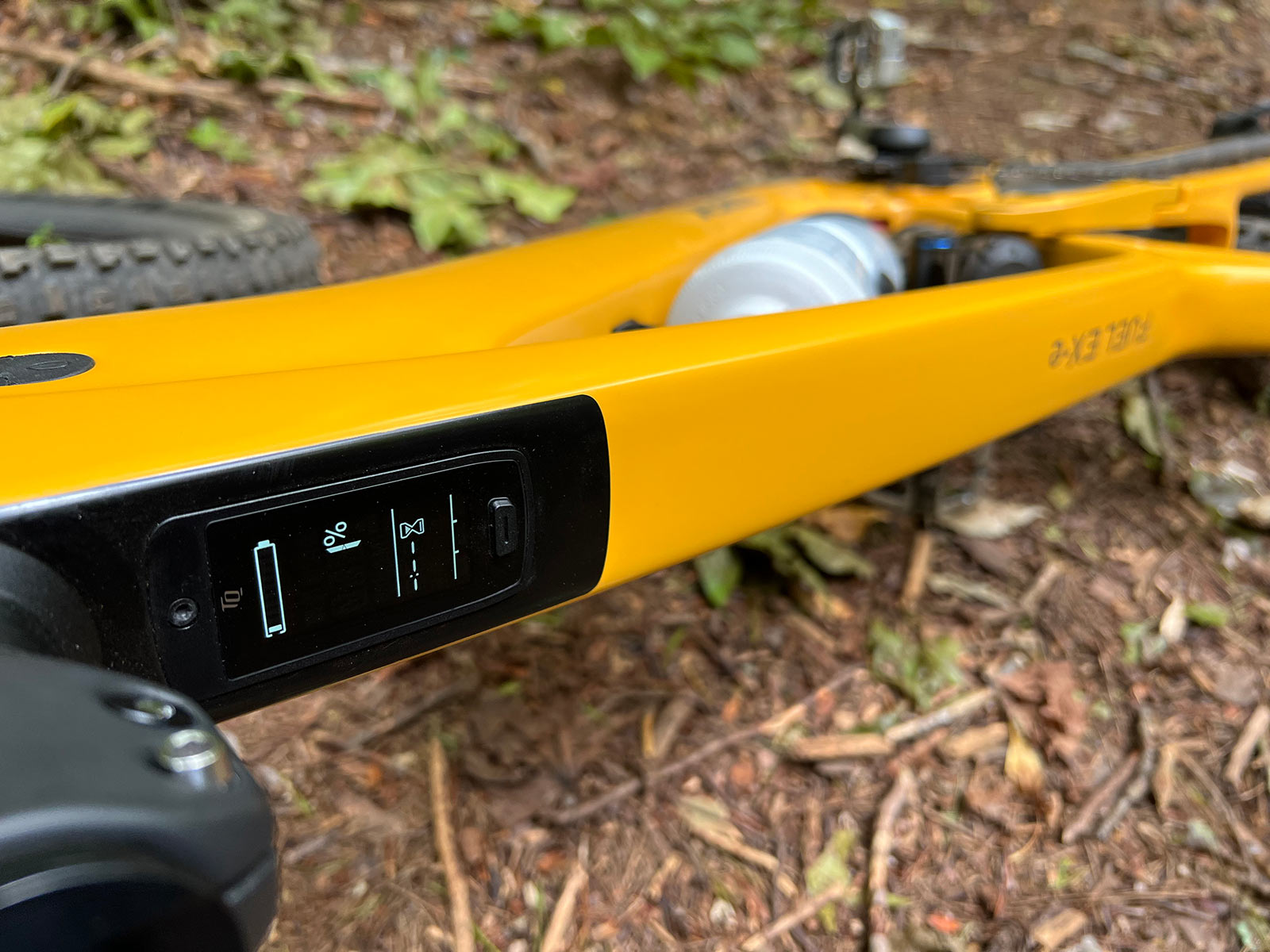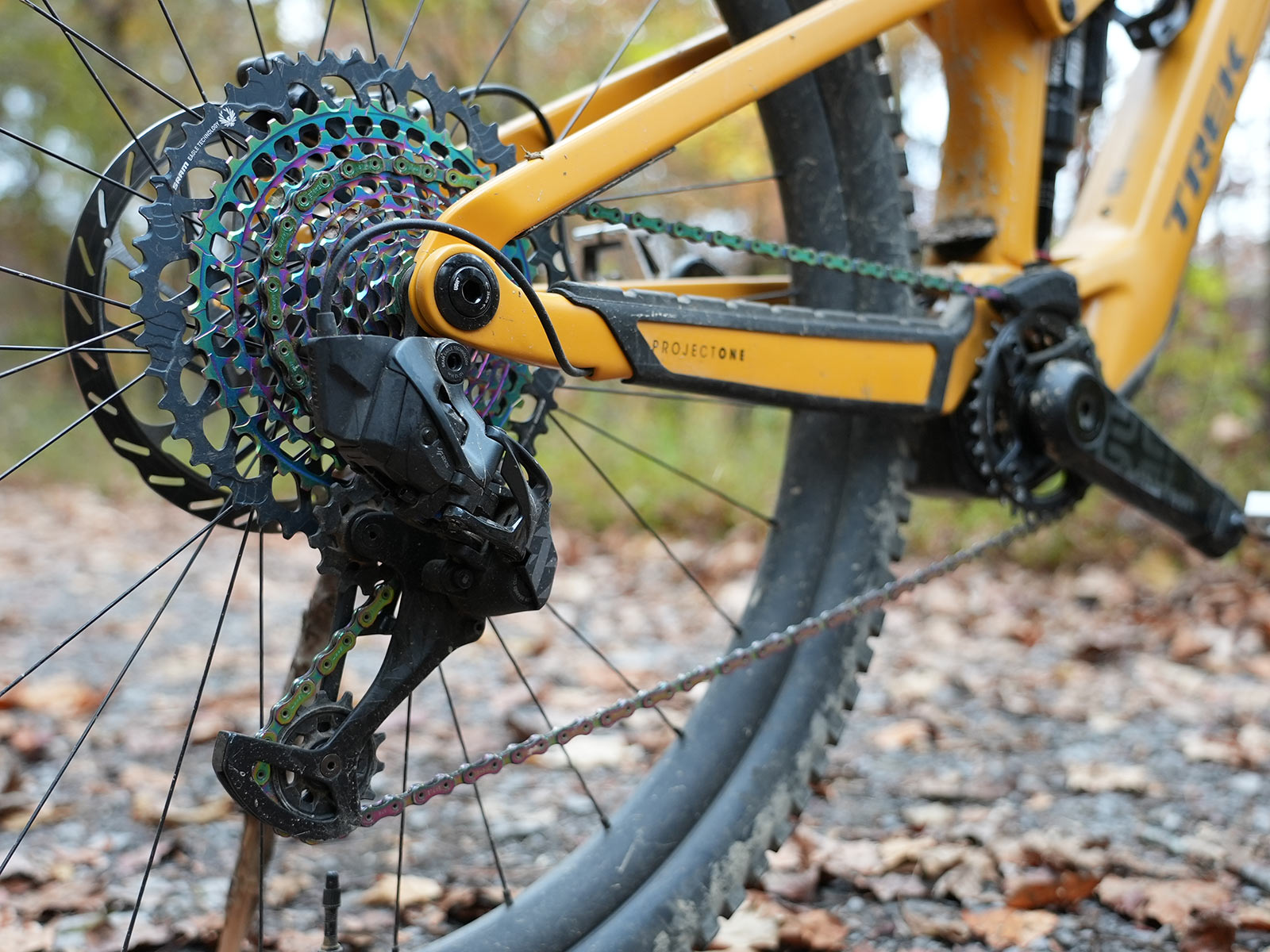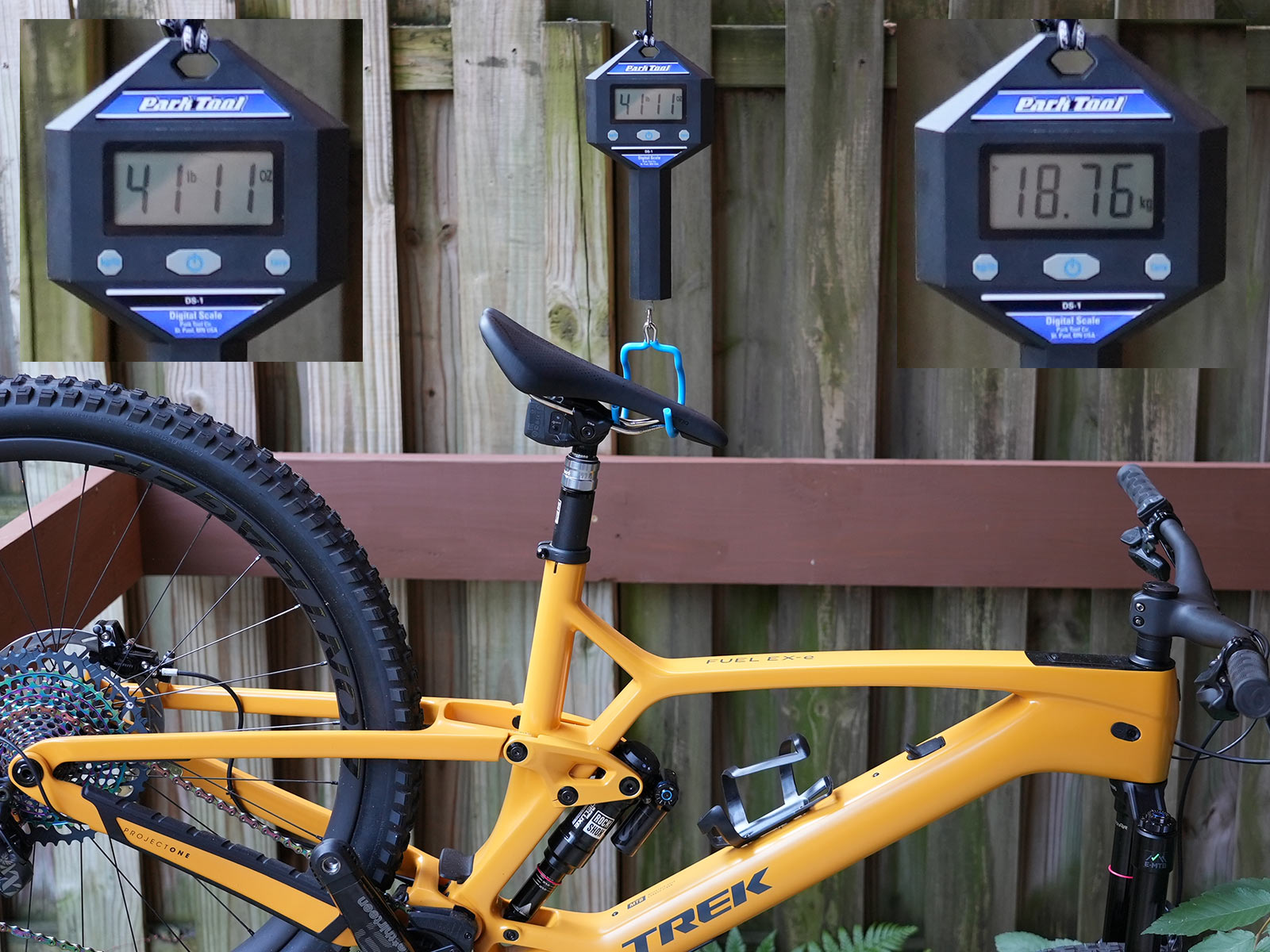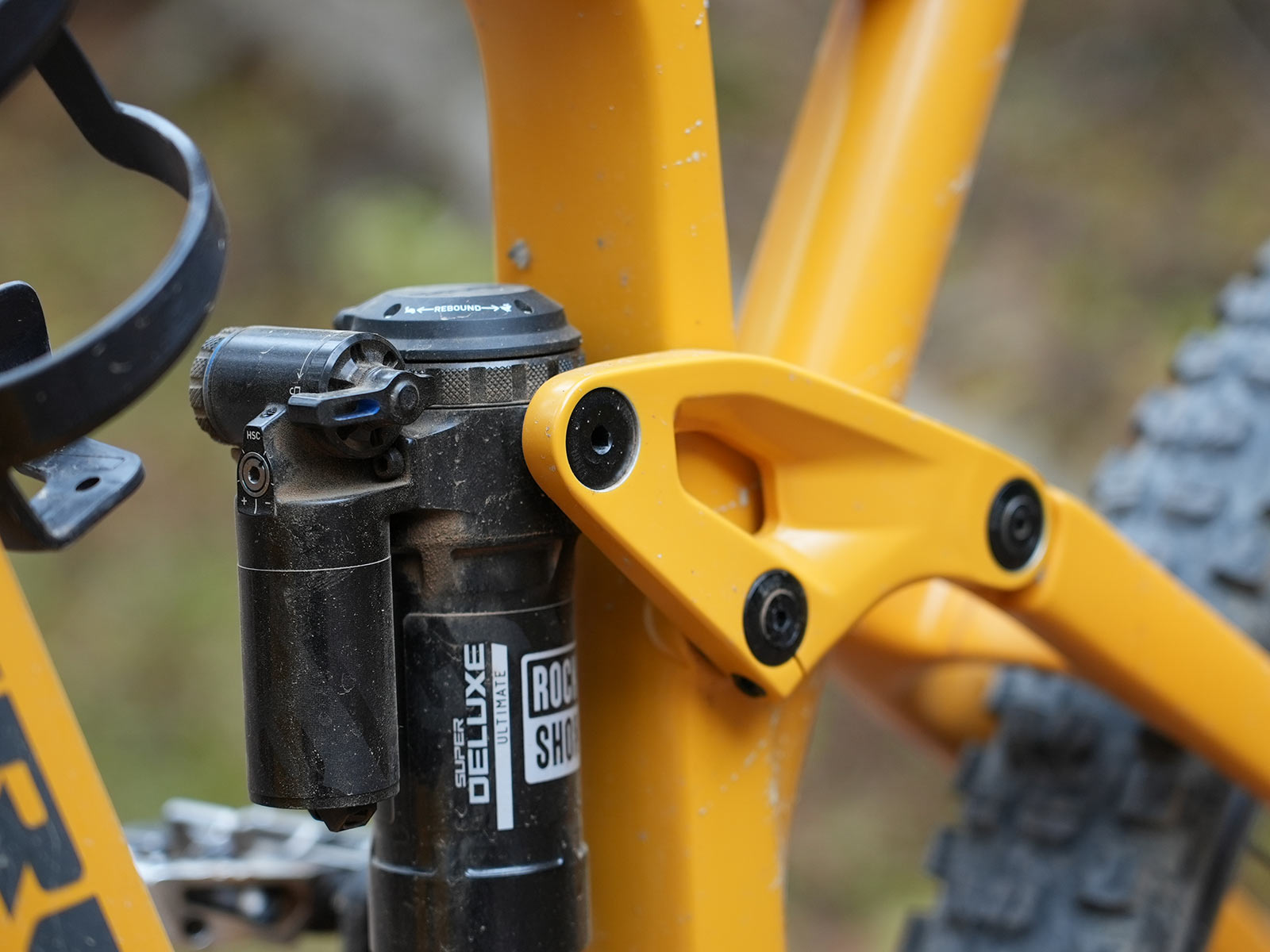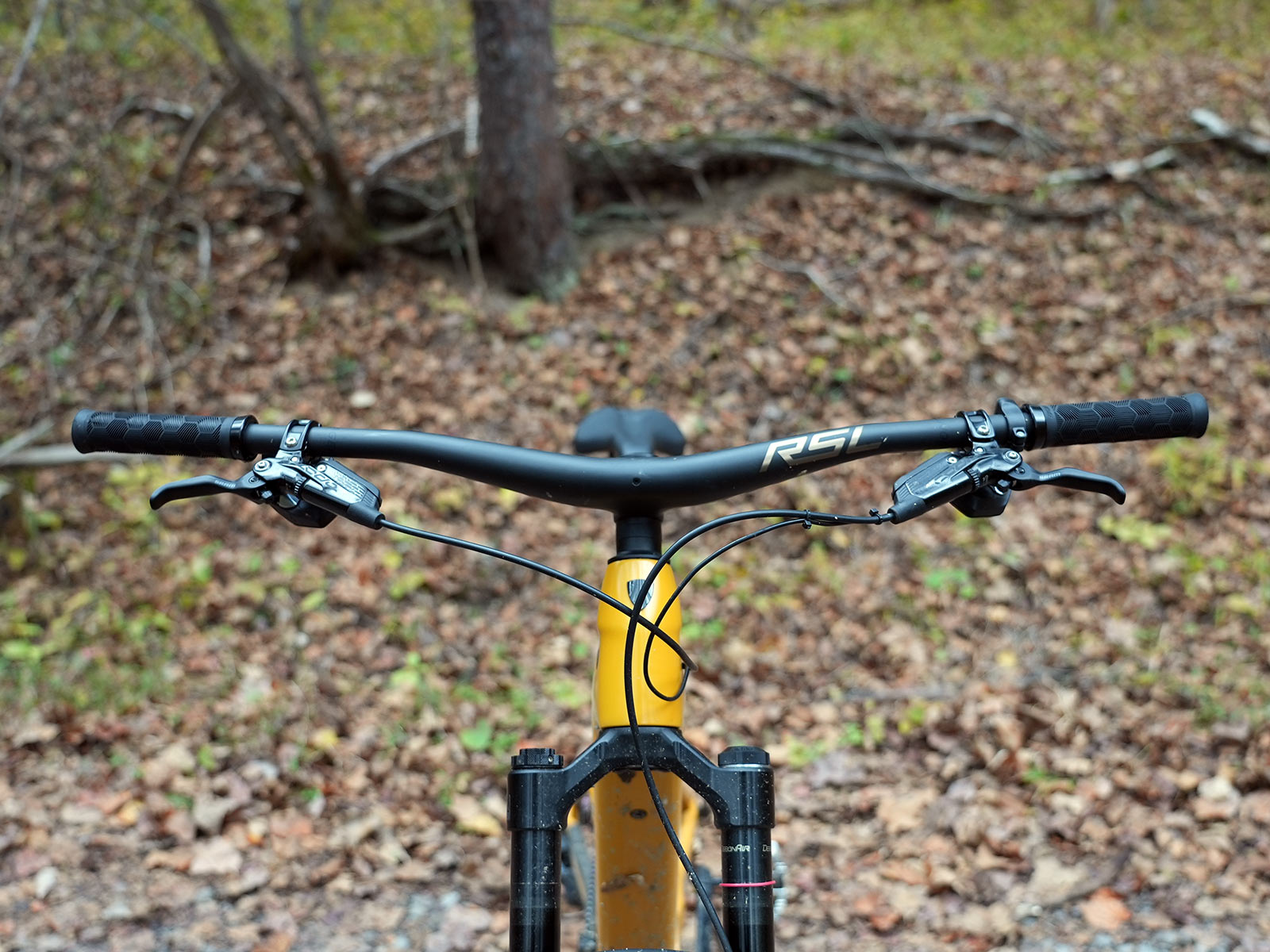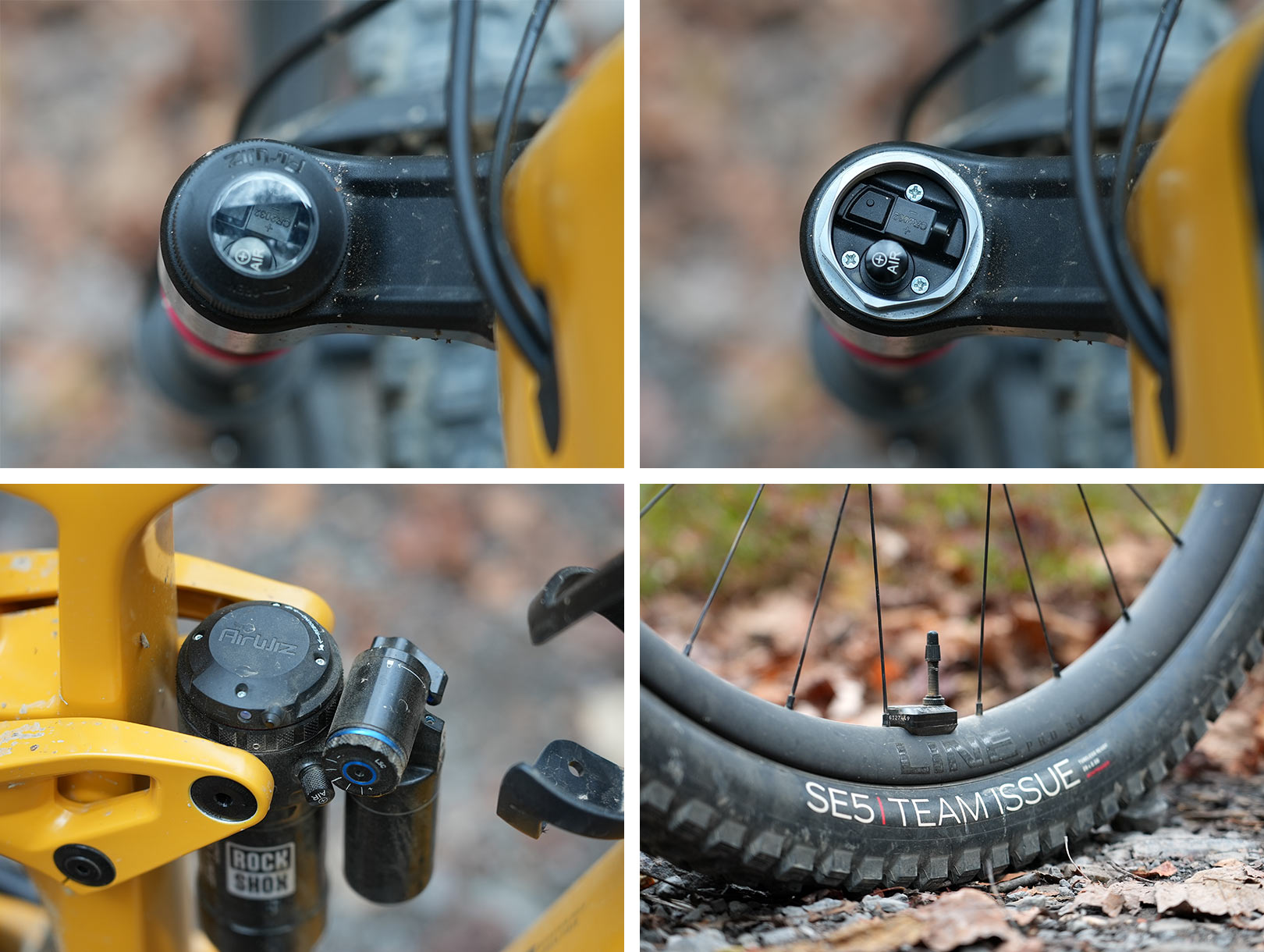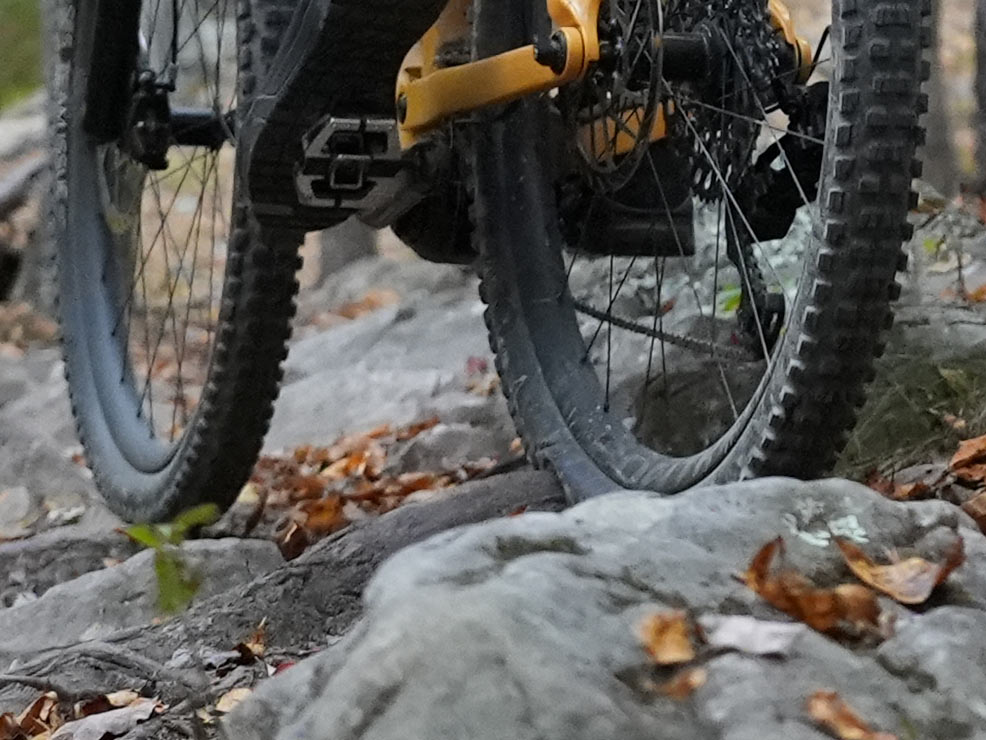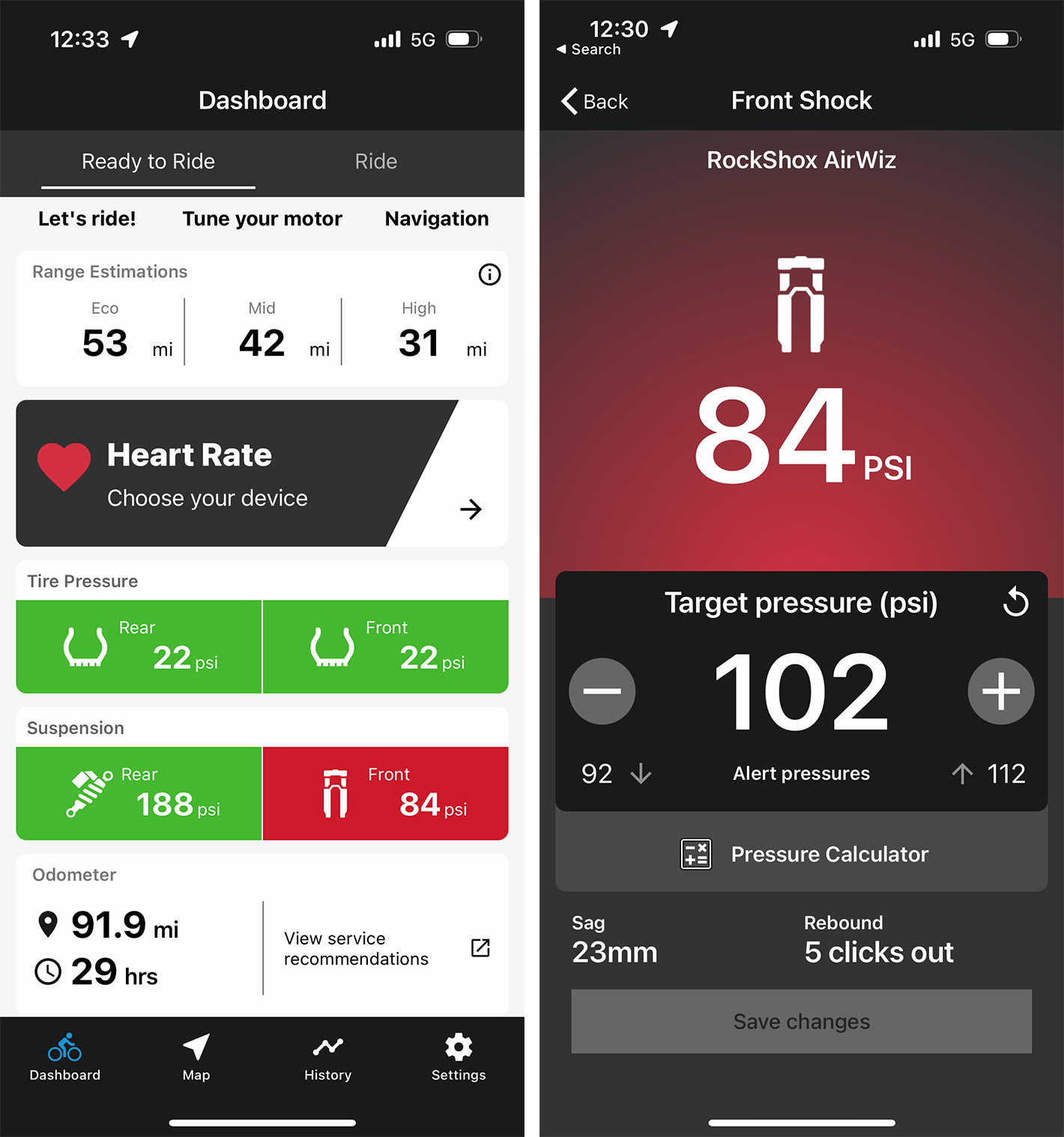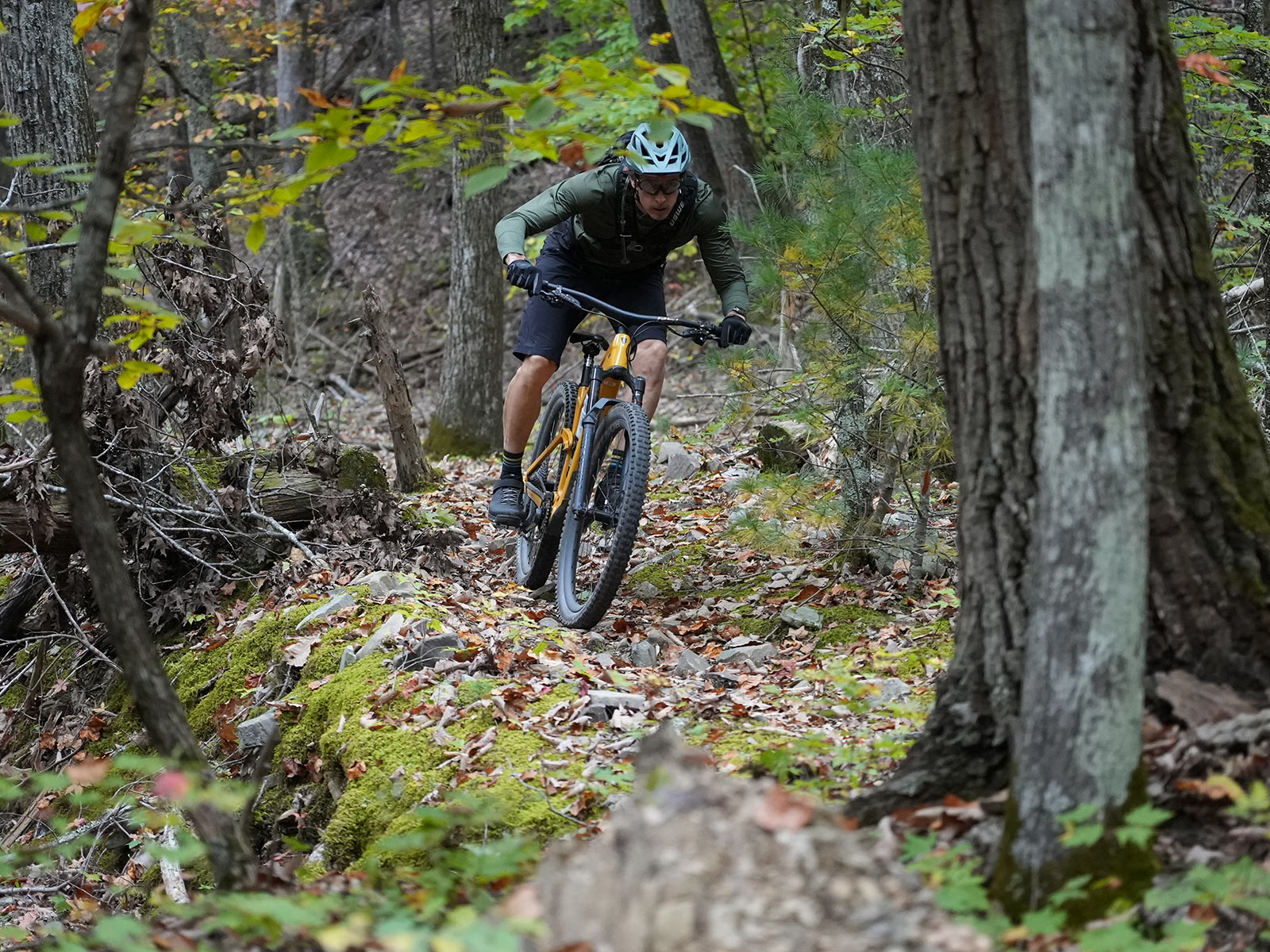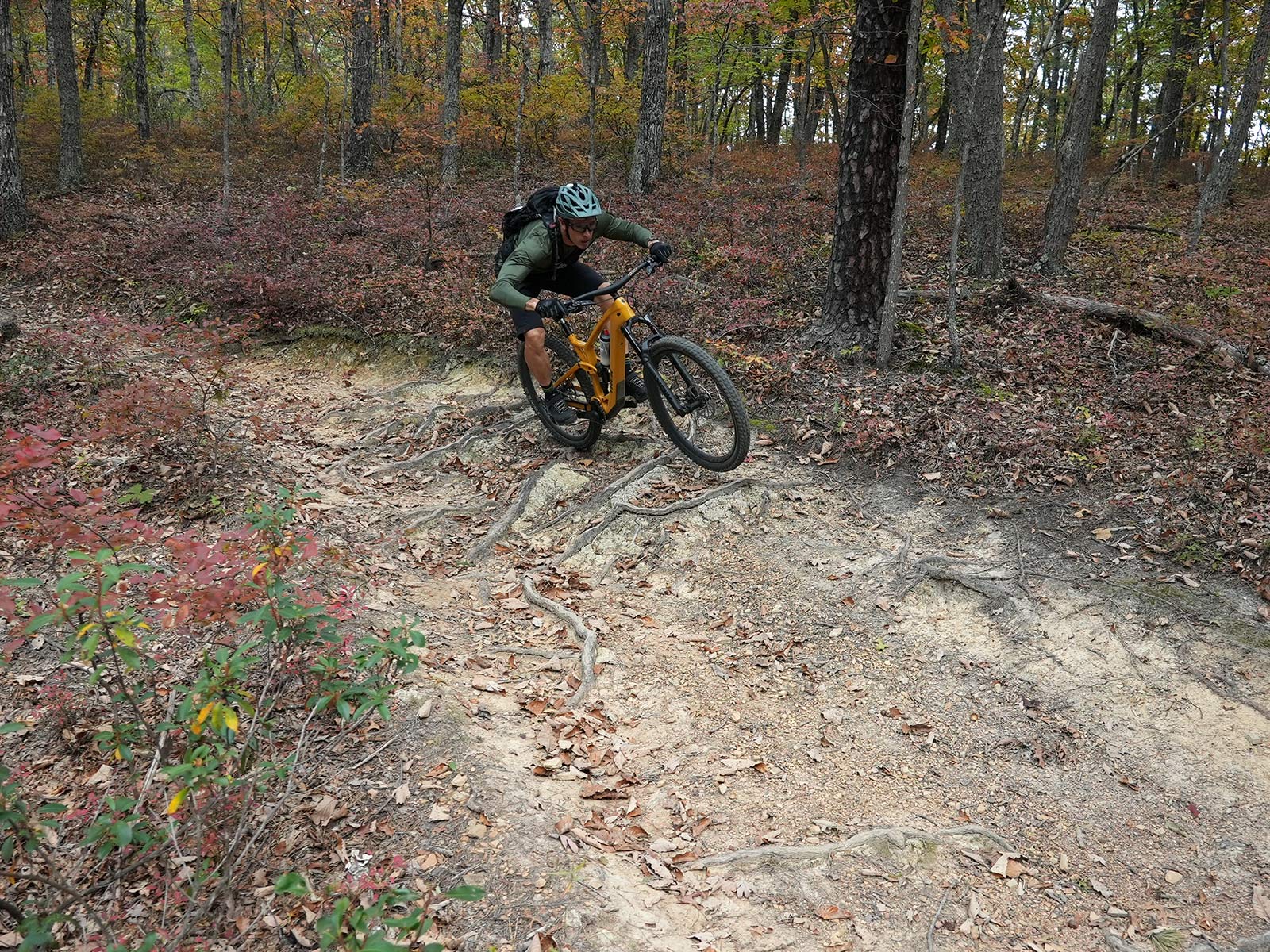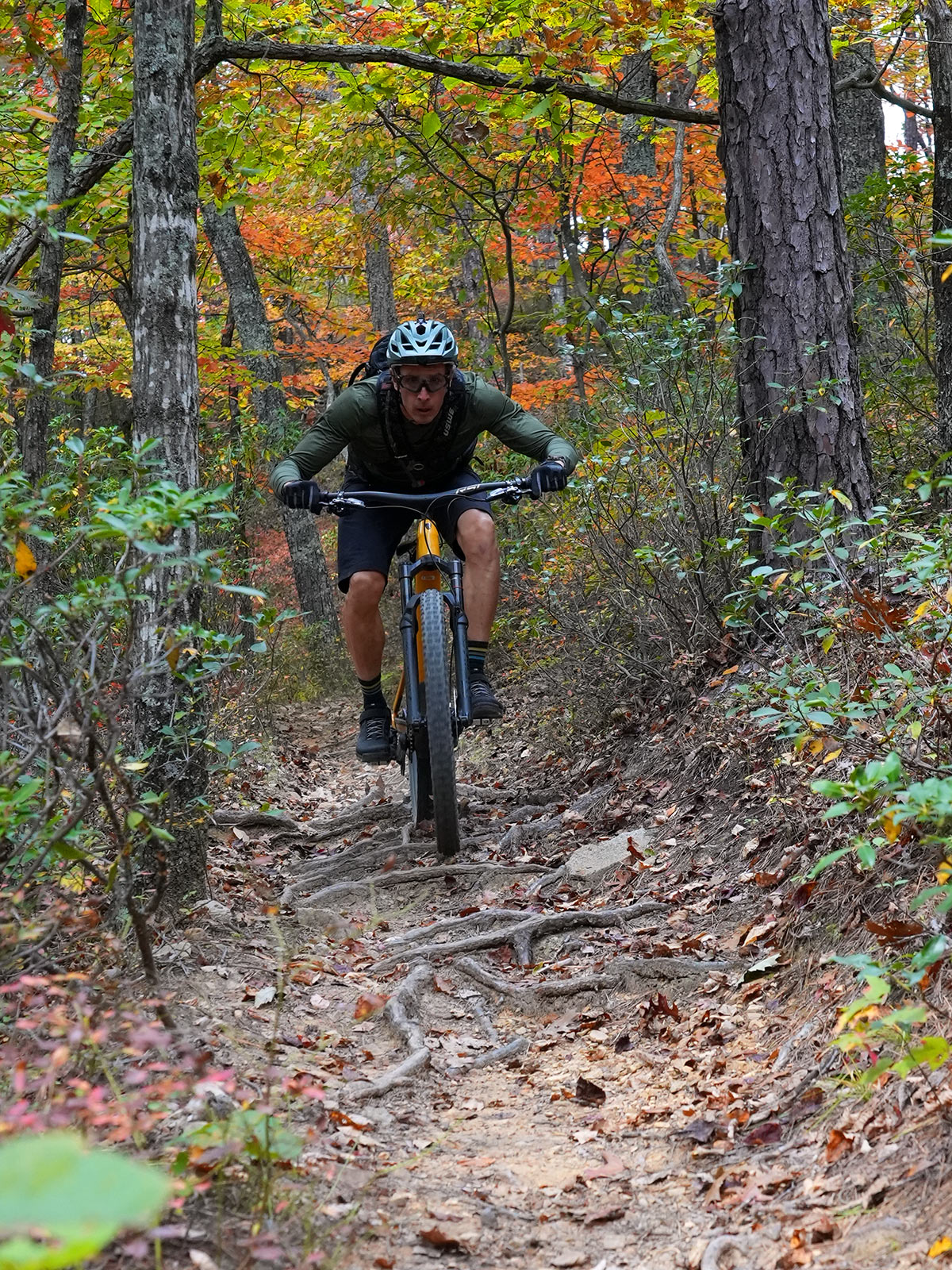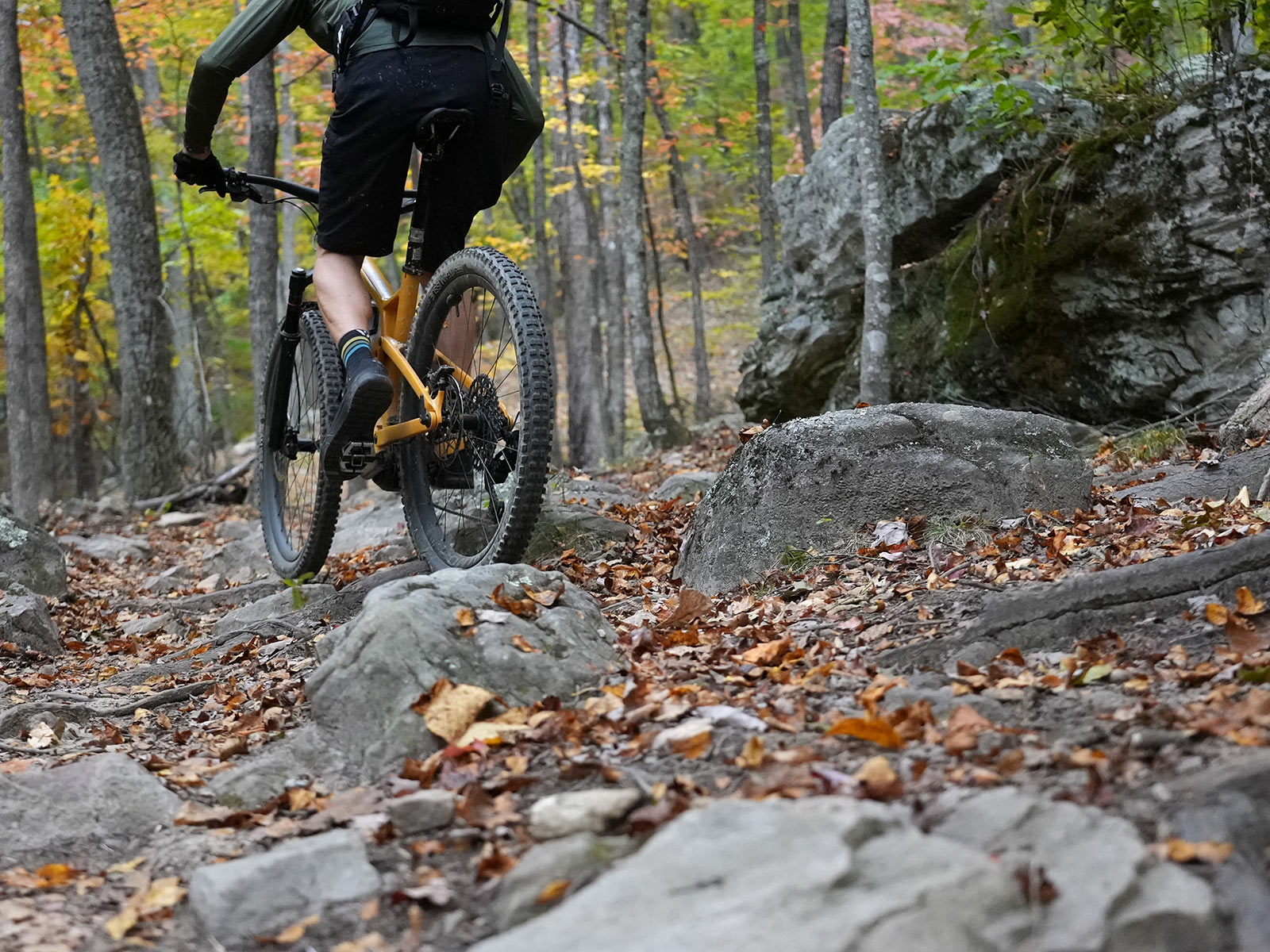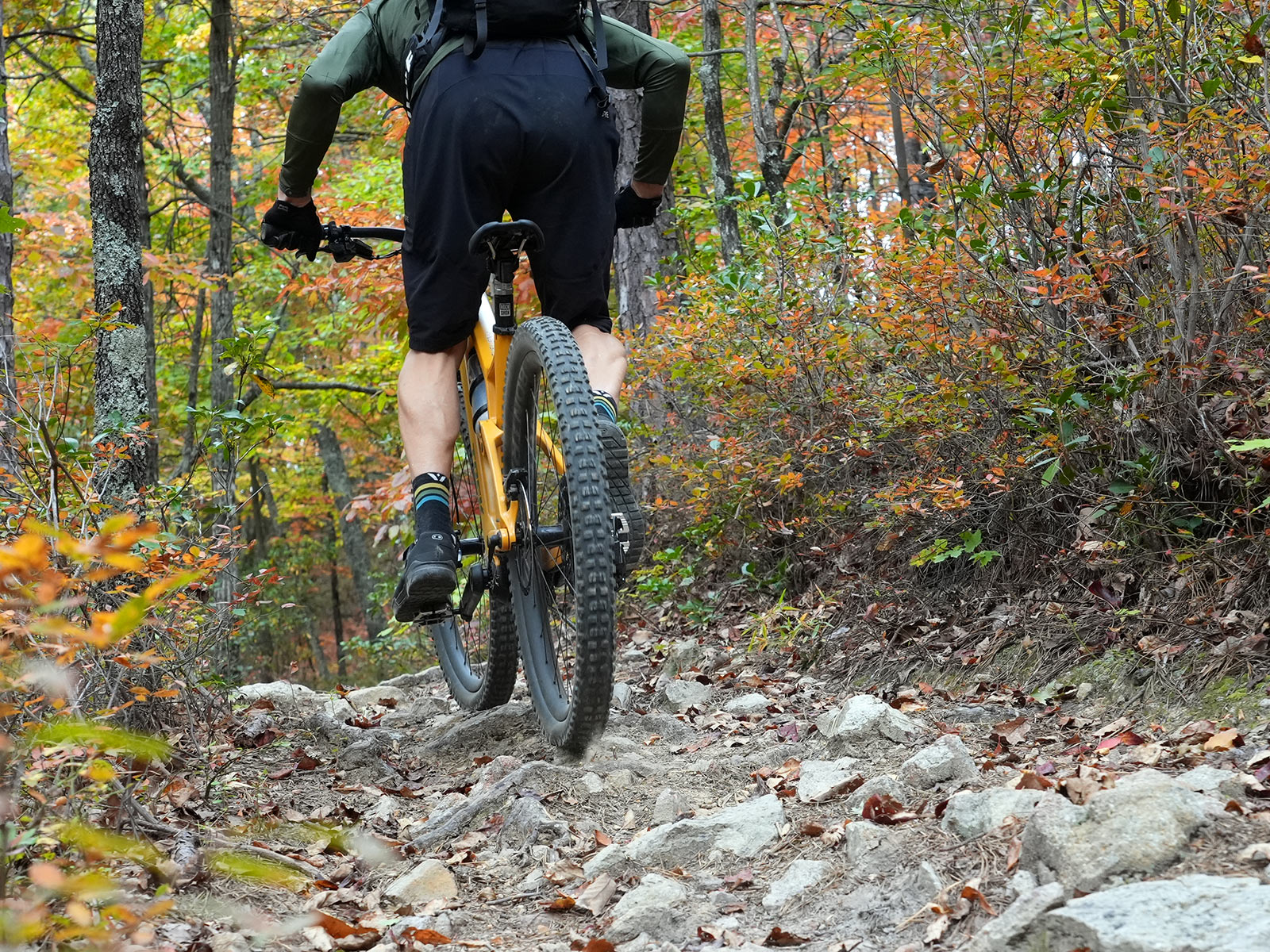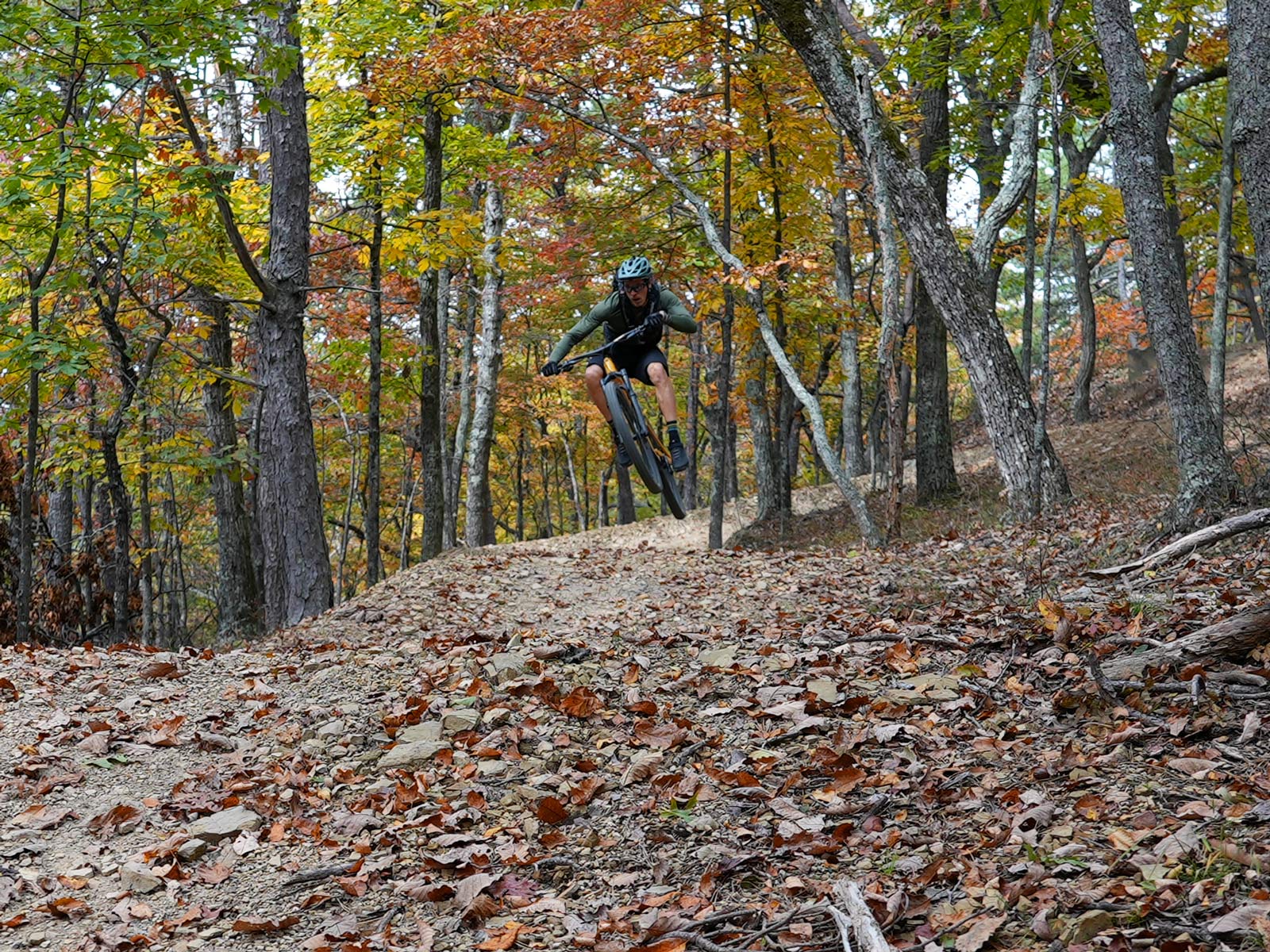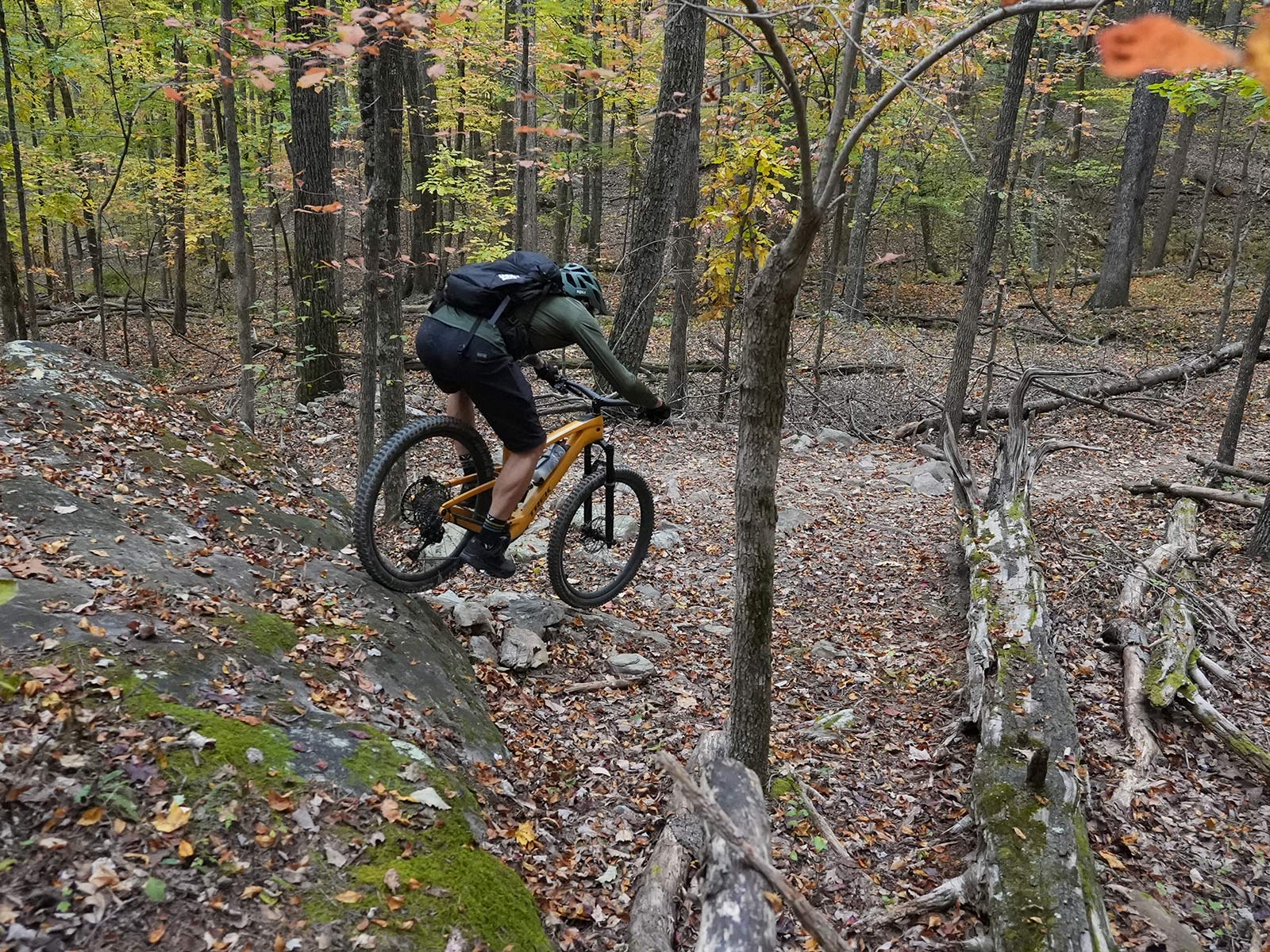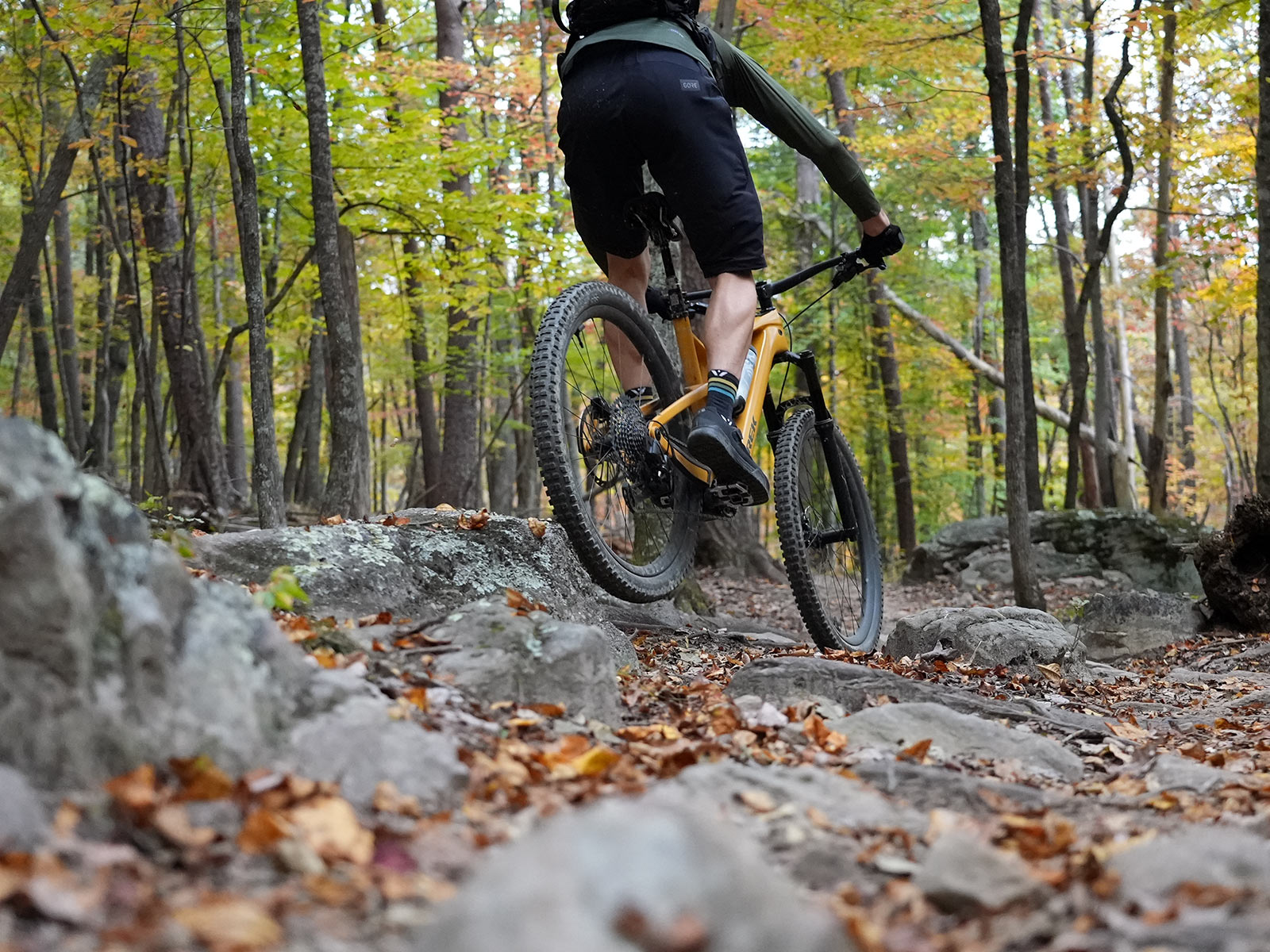The Trek Fuel EXe is a bit of an outlier in the current e-MTB market. Most e-mountain bikes fall into one of two categories: High-powered, long-travel beasts, or lightweight, short-travel models with lower-power systems.
The Fuel EXe sits in the middle, with 150/140mm travel and generous, adjustable trail geometry, and the new TQ HPR50 motor that’s ultra-quiet with moderate output. And it works, delivering a balanced, capable bike and an extremely fun ride experience.
If you’re looking for an eMTB that rides like a trail bike and helps you conquer bigger trails and longer days, here’s everything you need to know about the Trek Fuel EXe…
The Quick Overview
The Trek Fuel EXe translates their popular Fuel EX trail bike line into an electric-assist model that “empowers you to do more, without interrupting the way you experience nature.” That was the goal, and they nailed it.
It starts with a full OCLV carbon frame with fully internal routing and integrated TQ HPR50 drive system. The tiny motor sits where the BB is and still allows short 440mm chainstays. The 360Wh battery sits in the downtube and the power button/system monitor is flush in the top tube.
A simple two-button remote is barely visible on the bars. It cycles through the modes, initiates Walk Mode, and a long press of the lower button will turn off all assist. Meaning, default is Eco mode, you have to hold the lower button for about 3 seconds to turn assist off…I wish it was just a quick press as for the other modes.
The bike has 29er wheels front and rear, 140mm rear travel paired to 150mm forks, a 65º head angle, and 77º effective seat angle (in Low position; their Mino link flip-chip lets you tweak the geo by 0.5º steeper in High).
Size-specific dropper posts range from 120mm to 170mm in travel depending on frame size. All sizes get 165mm cranks.
Check our launch coverage for the full tech story on this bike.
How’s the TQ motor?
It’s brilliant. Until I thought to pay attention to it, I heard nothing.
And when I was paying attention, it sounds like a light, barely perceptible whistling of the wind.
The sound of my friend’s regular eMTB riding 20 feet behind me drowned out any noise from this bike.
Basically, noise is no issue here, not even at maximum power. You truly do hear nature, not the bike.
This is because the motor has no belts or gears. Trek has a great breakaway view of it, and we covered the tech in depth if you’d like to dig deeper.
The TL;DR is this: It’s ultra quiet, pumps out smooth power delivery, and 50Nm of torque is plenty to help you along the trail and up the hills. It’s also ultra-light, weighing 2.5+ pounds less than competitors’ larger 85-90Nm motors. As such, it uses a smaller, lighter battery without giving up range or ride time.
What about battery life?
Trek claims 2-5 hours of ride time per charge. With judicious use of Eco mode, I routinely got more than 3 hours of riding on a single charge. That means mixed use of mostly in Eco but using Trail mode on most climbs and Turbo on the steepest climbs.
Fortunately, Eco felt just right when pedaling along. Trail was fun, and a bit faster, but mostly not necessary for keeping up with others.
That said, when riding with others on eMTBs with more powerful systems, it was clear that they were faster. But on the trail, in the woods, things evened out enough that we all just rode together perfectly fine. I never felt under-gunned unless we were nailing it up a smooth fire road.
A 160Wh Range Extender is available for $599 and adds 44% more capacity. It’ll take up the single bottle cage on the bike, but it’s worth it for big days when range anxiety is a real thing. Personally, I’d add it to the cart.
One note: Fresh out of the box, TQ says the system needs a few full charge and discharge cycles to accurately estimate range and battery life.
My first ride’s assistance abruptly ended with 7% battery showing on the display. My second ride ended at 3%.
Subsequent rides are getting closer to 0%, but even at 0% showing, there’s a small reserve left to power the electronics. Which is crucial because the SRAM AXS rear derailleur is plugged into and powered by the bike…not its own battery.
Starting with 1%, I still managed to get 2.5+ hours of riding out of it before it finally, fully shut down and left me with a single speed.
Yes, you can borrow the battery from the Reverb AXS and use that, but then the wire and plug leading to the derailleur are left dangling about… and likely to get ripped off or sucked up into the chain.
Fortunately, the system also charges quickly, getting to about 80% in about 90 minutes, and fully charged in about 2.5 hours.
It’s worth noting that when TQ’s system drops below 10% charge, it limits output to Eco mode regardless of the setting you choose. This helps ensure you maximize your range.
Why not just get a high-powered eMTB?
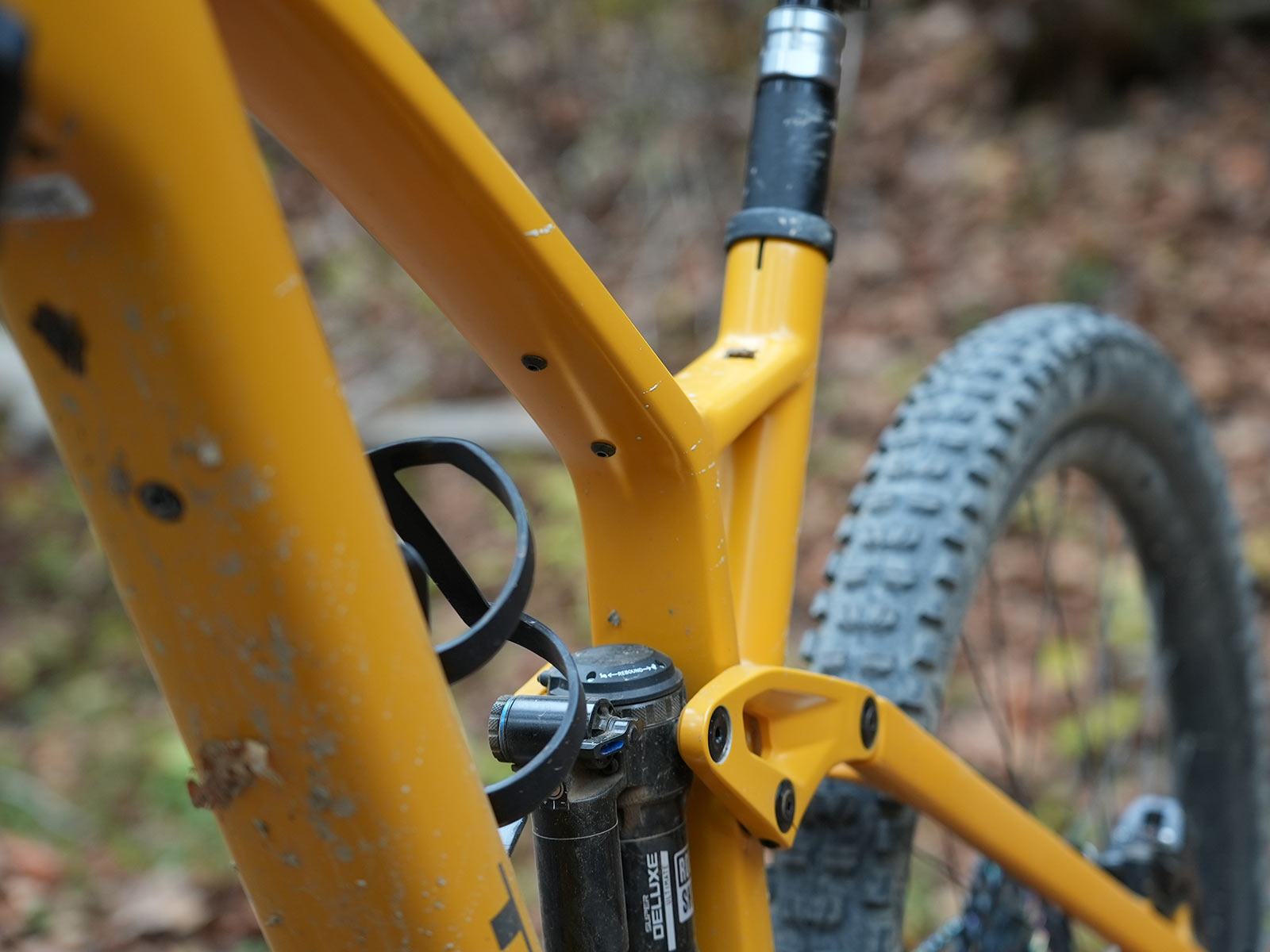
I’ve been asked, “yeah, but if you’re paying for an eMTB, why not just get a high-powered e-MTB?”
That’s a good question. I have a couple of good answers.
First, this bike is a lot lighter, at least 10lbs lighter. It’s entirely pedal-able even without assist, something I unwittingly proved when I showed up at the trailhead and realized I hadn’t charged it.
Three hours later, I was spent, but had a great time riding. Granted, this was on flowing trails without any massive, long climbs, but I still had hundreds of little punchy climbs and sprints to get up and down the trail.
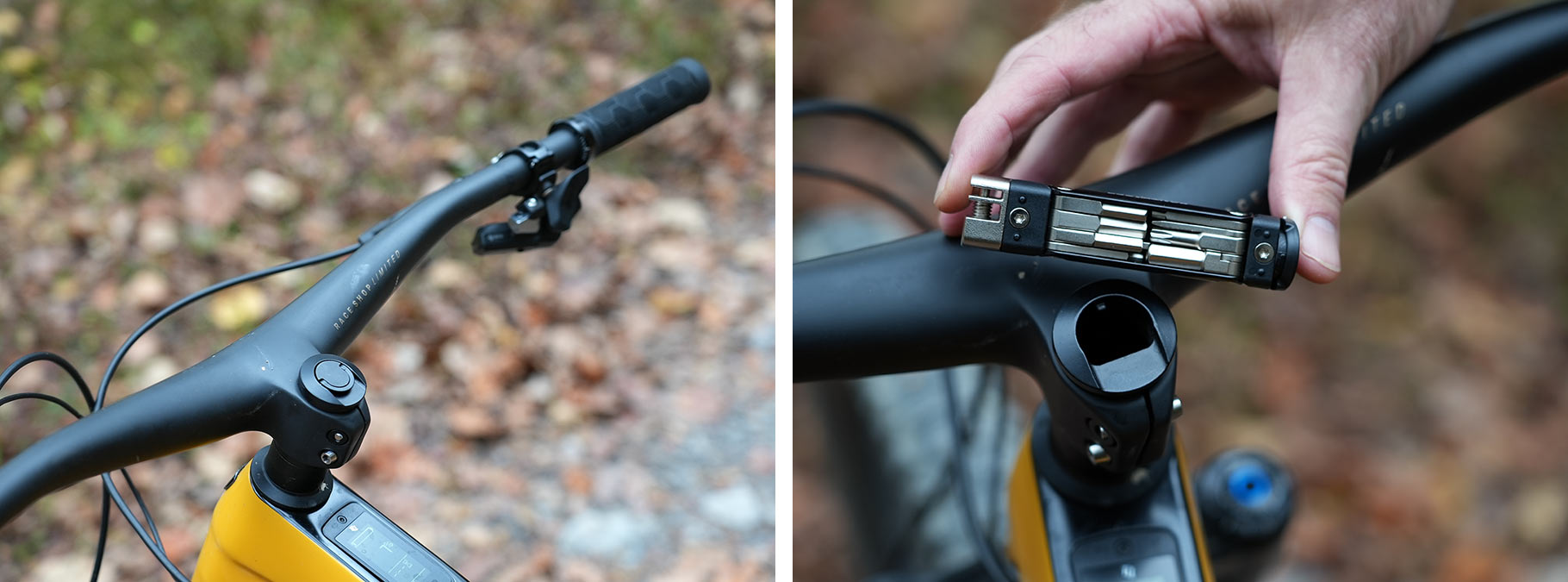
Second, full power feels about like half power compared to a top-level Bosch- or Shimano-equipped bike. But that’s OK. The Fuel EXe’s output feels more natural, so if you’re looking for an e-bike that rides like a regular bike, this is it. It just lets you get a little further a little faster. Big days can be bigger. Little days can be a little faster.
On loose, technical, or entirely too steep climbs, I actually preferred the lower output of the Fuel EX-e. It was more than enough to help me up (I still had to work), but it wasn’t spinning out or lurching out of control where more powerful bikes were. It makes really steep, sketchy climbs more manageable.
But if you want more power, check out the Trek Rail. If you want no power, we reviewed the non-electric version of this 2023 Trek Fuel EX with this same spec, too.
How much does the Trek Fuel EXe weigh?
I tested the top of the line Trek Fuel EXe 9.9 XX1 AXS in size XL. It weighed in at 41lb 11oz (18.76kg) without pedals…and that’s with an impressive (and expensive) mix of both lightweight and tech-laden parts.
Trek says the entire TQ HPR50 system adds just 3.9kg (8lb 10oz). The EXe is only about 10lbs more than the nearly identical-looking standard Fuel EX, so they didn’t add much beyond the TQ system to make it an e-bike.
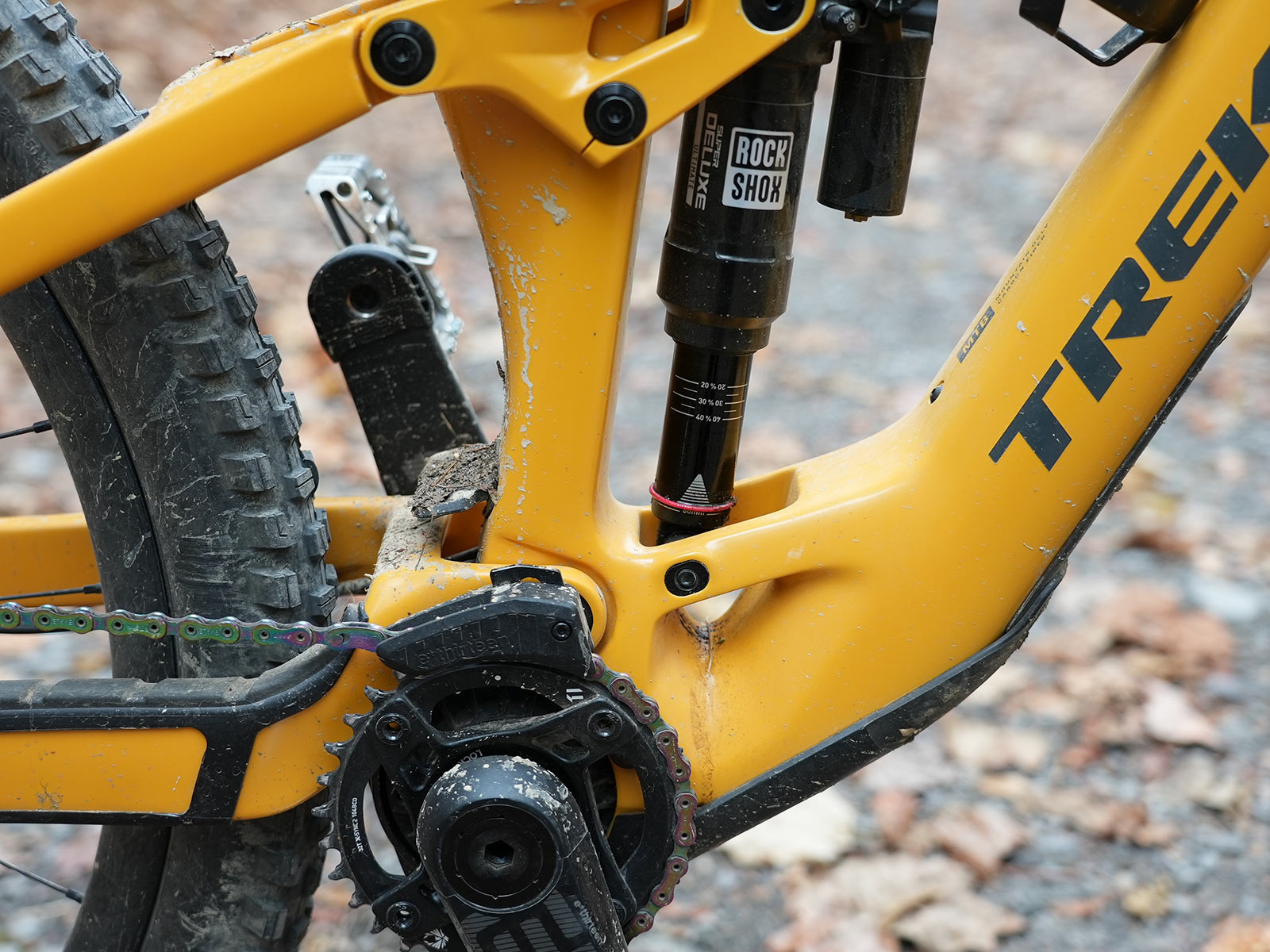
The frame feels stiff and robust. The tires are big and meaty.
The bike looks tough, with square-ish tube profiles and wide cross sections. All of that adds up to an extremely laterally stiff frame.
The one-piece RSL handlebar stem and Line Pro 30 carbon wheels save weight, but as a percentage of total bike weight, they’re not making the same impact they would on an analog bike. And, at 820mm wide (on all frame sizes!) it’s really wide…if it were mine, I’d cut it down (they include marks measured to 740mm).
I’d also probably switch the grips to something with a bit more vibration damping. If you choose a model with a standard handlebar and stem, I’d recommend something like the OneUp or Race Face trail handlebars with added compliance.
Too much tech?
Other spec highlights on this particular trim level include a complete SRAM AirWiz and TireWiz system, offering remote tire pressure and fork & shock pressure monitoring.
The Trek App shows recommended tire, fork, and shock pressures based on your riding weight, along with starter rebound settings. With AirWiz/TireWiz installed, their app will also show current actual pressures, too.
Check it there, or just look for the blinking lights on the bike to be green, and you’re good to go. Red lights mean something’s out of the recommended range.
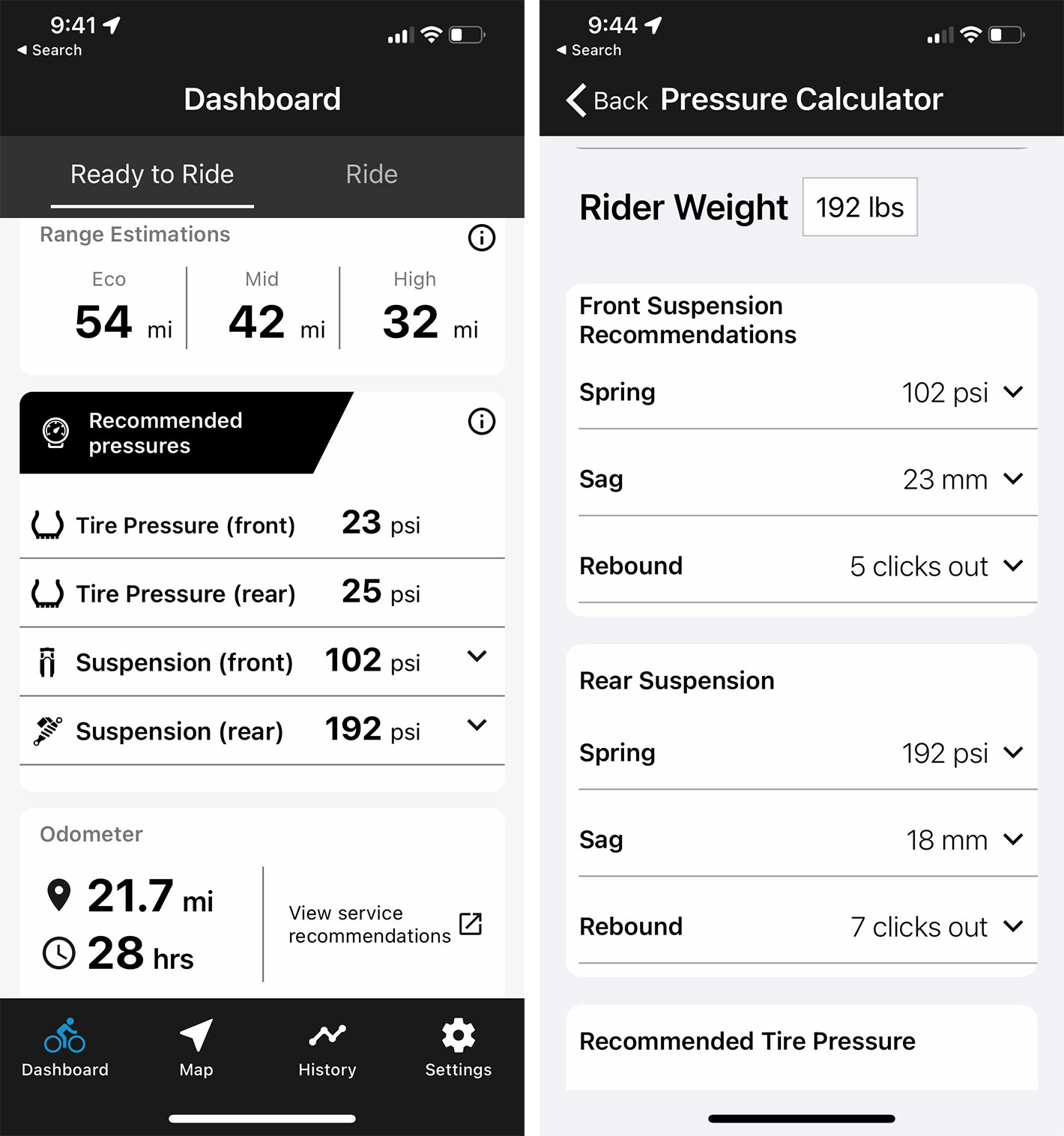
I found that the recommended tire pressure settings were a tad high. I ended up at 22psi front and rear with no issues (I’m about 192-195lbs fully kitted out, ready to ride).
The Bontrager SE5 Team Issue 29×2.5 tires are excellent, I run them on some of my other bikes, too. Like most aggressive trail tires, and particularly those spec’d on e-bikes, the casings are stiffer and can take a lot of abuse, so lower pressures help improve ride feel. I may still go a bit lower.
At 22psi, they’ll mold to the ground and take a hit, but I still haven’t felt a rim strike despite some obvious deformation over roots and rocks.
The rear shock’s air pressure recommendation was spot on, giving me full travel on the big days.
The fork, however, was too high. Trek recommended 102psi, but even at 87psi I was only getting ~85% travel. I’m still tinkering here, down to 84psi, but the takeaway is that you don’t have to stick to the recommended settings.
And, once you find what you like, you can use the Trek (or SRAM’s AXS) app to manually set your preferences. If the bike has the Air/TireWiz devices, those will be updated to blink red/green accordingly, too.
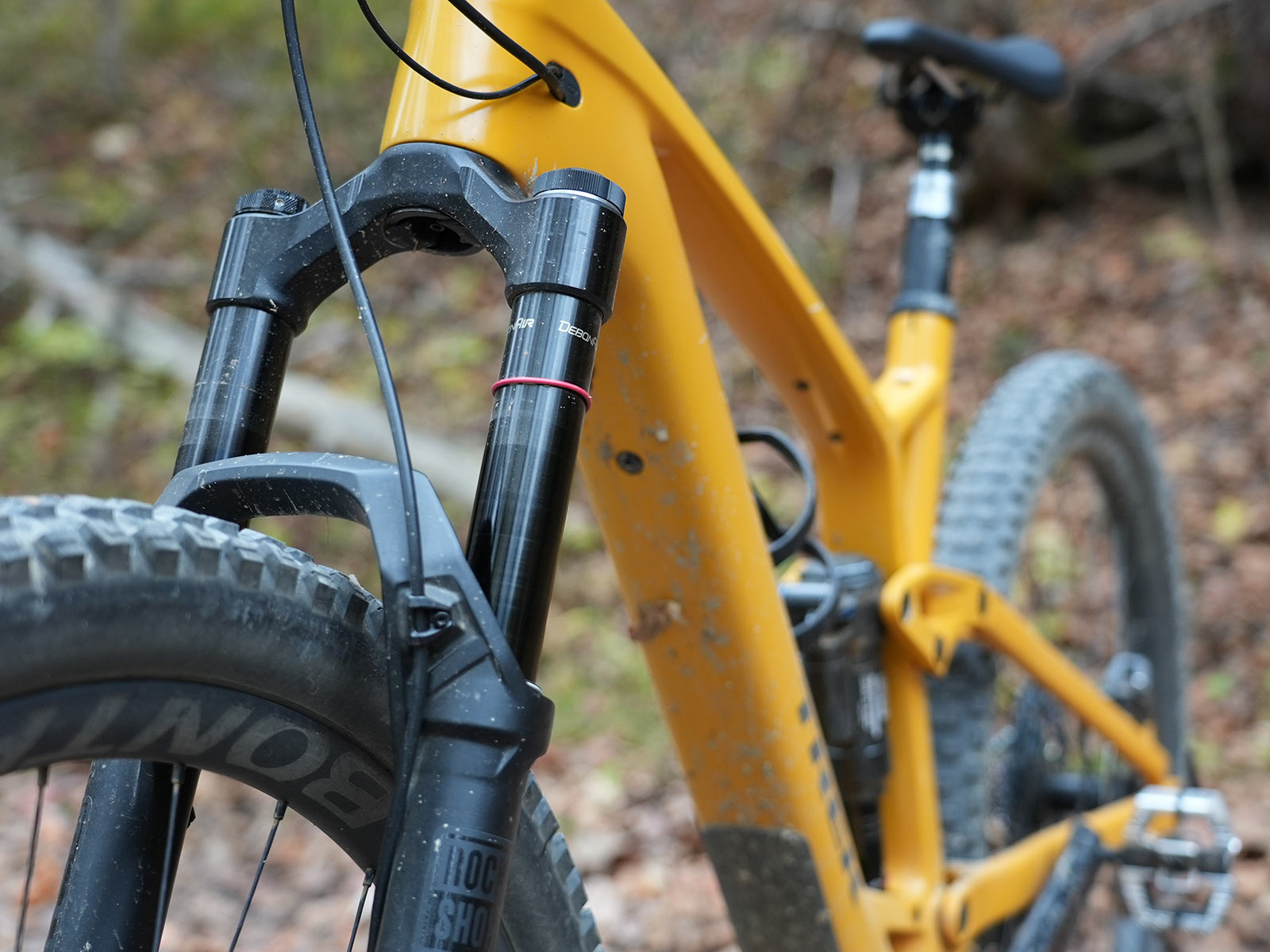
Personally, I think the Wiz devices are clever, but overkill, and they definitely add cost. I like that I can set my preferences and use the Trek app to save them (because I will definitely forget), but I could take or leave the extra electronics on the bike…and, if I were shopping, would probably opt not to pay for that tech here.
How does the Trek Fuel EX-e ride?
In short? It rides like an aggressive trail bike. A really good aggressive trail bike.
Trek’s ABP suspension is efficient and effective. There’s a lockout switch on the rear shock, but in most instances it’s not needed. I only used it on long fire road stretches or when riding the road to the trails. Once on the dirt, it stays open with no issues on sprints, standing climbing, or just powering along.
On the descents, I could smash through extended rock and root sections, prevalent on the trails at Carven’s Cove near Roanoke.
While I’m still fiddling with the fork’s air pressure to improve small bump and low speed comfort, the Lyrik Ultimate on this bike absolutely demolished high speed hits.
Combined with the stiff frame and capable tires, the Fuel EXe inspires a lot of confidence at speed over gnarly terrain.
The suspension stays active under power, which is good because I (like most eMTB riders, according to research) tend to stay seated more often on e-mountain bikes. The motorized assist helps a rider power through rough stuff in theory, and a good suspension platform like this makes it happen in reality.
The Fuel EXe hammers through the rough stuff when standing, too, maintaining traction.
Situations like these, where a little bounce and skip is inevitable is another argument in favor of moderate power output from the motor. Never once did I spin out, and never did I really wish for more power. It’s a good balance.
The bike’s geometry is perfectly balanced, too. I could easily maintain rear traction while keeping the front wheel firmly on the ground, even on some monstrous 18%+ loose, rutted fire road climbs.
Even the bike’s weight feels well-balanced, in terms of handling. Jumps feel natural…
…as do drop-ins…
…and drop offs.
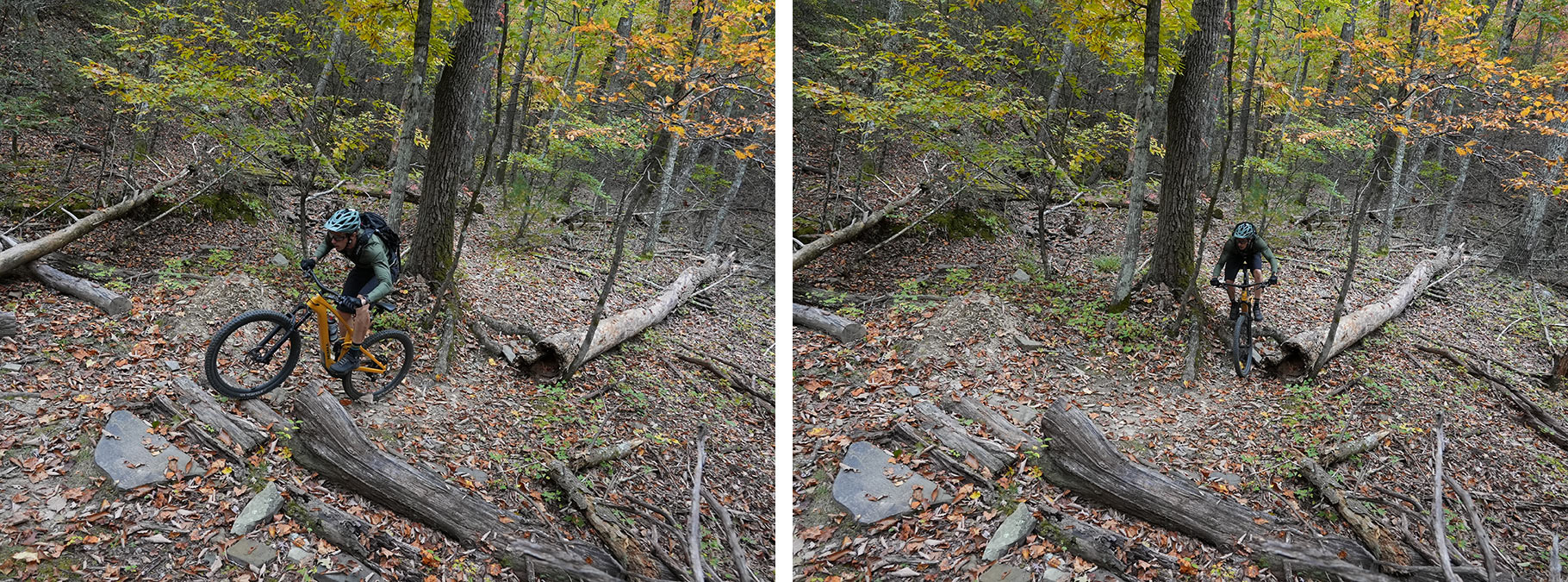
But there’s a definite heft to getting the front wheel up and over logs or rocks.
The result was that I’d just smash into stuff that I would usually pop up and over on a regular bike. Up to a point, of course … there are some things you simply have to lift the wheel up and over, so just know that it takes more effort.
Which means riding this bike, despite its relative light weight, is more of a full-body workout, as is any eMTB. And I feel like I pedaled more consistently and turned more total revolutions, many times also riding a bit longer than I otherwise would have.
The point is, at the end of each ride, I was all grins and knew quite well that I’d earned them. Well done, Trek.
